Spring, summer, or fall, container planters can be filled with flowers and foliage plants to enliven porches, patios, and walkways with color. A single plant in a container can make a statement, but if you’d like to create a professional-looking container garden that can rival anything you’d find in a gardening magazine, you will want to use three types of plants in your arrangement. Those plants are generally known as thrillers, fillers, and spillers, and combining them in a single planter can make your container arrangement look much more complex and refined.
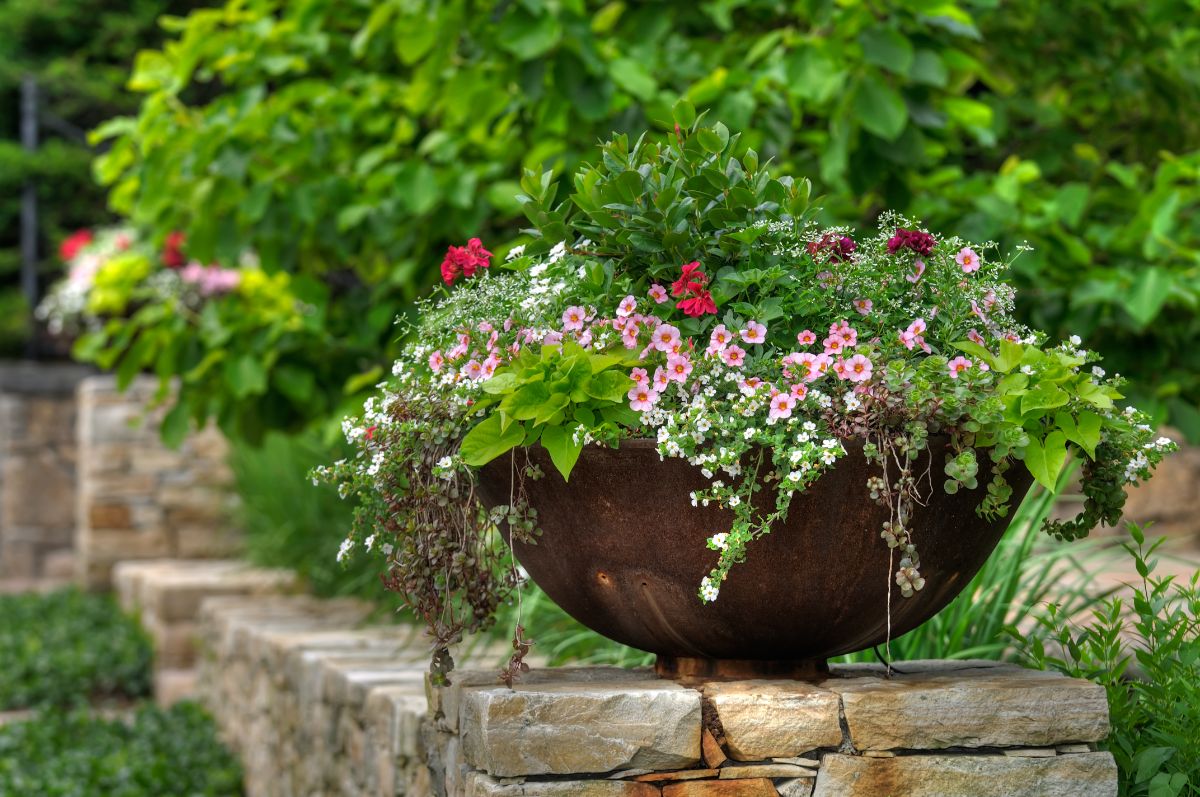
While you can certainly experiment with other thriller, filler, and spiller plants, you’ll find some of our favorite picks in the list below. Feel free to mix and match these plants to create a container garden that’s totally unique to you!
Jump to:
- Thrillers
- 1. Dracaena
- 2. Millet
- 3. Purple fountain grass
- 4. Mums
- 5. Cane begonias
- 6. Dwarf sunflowers
- 7. Dwarf hibiscus
- 8. Mandevilla
- 9. Canna lily
- 10. Caladium
- Fillers
- 1. Corkscrew rush
- 2. Dusty miller
- 3. Pentas
- 4. Petunias
- 5. Coleus
- 6. Swiss chard
- 7. Impatiens
- 8. Begonias
- 9. Herbs
- 10. Heliotropes
- Spillers
- 1. Sweet potato vine
- 2. Creeping Jenny
- 3. Sweet alyssum
- 4. Inchplants
- 5. Ivy geranium
- 6. Nasturtium
- 7. Variegated ground ivy
- 8. Fuchsia
- 9. Asparagus fern
- 10. English ivy
- Summary
Thrillers
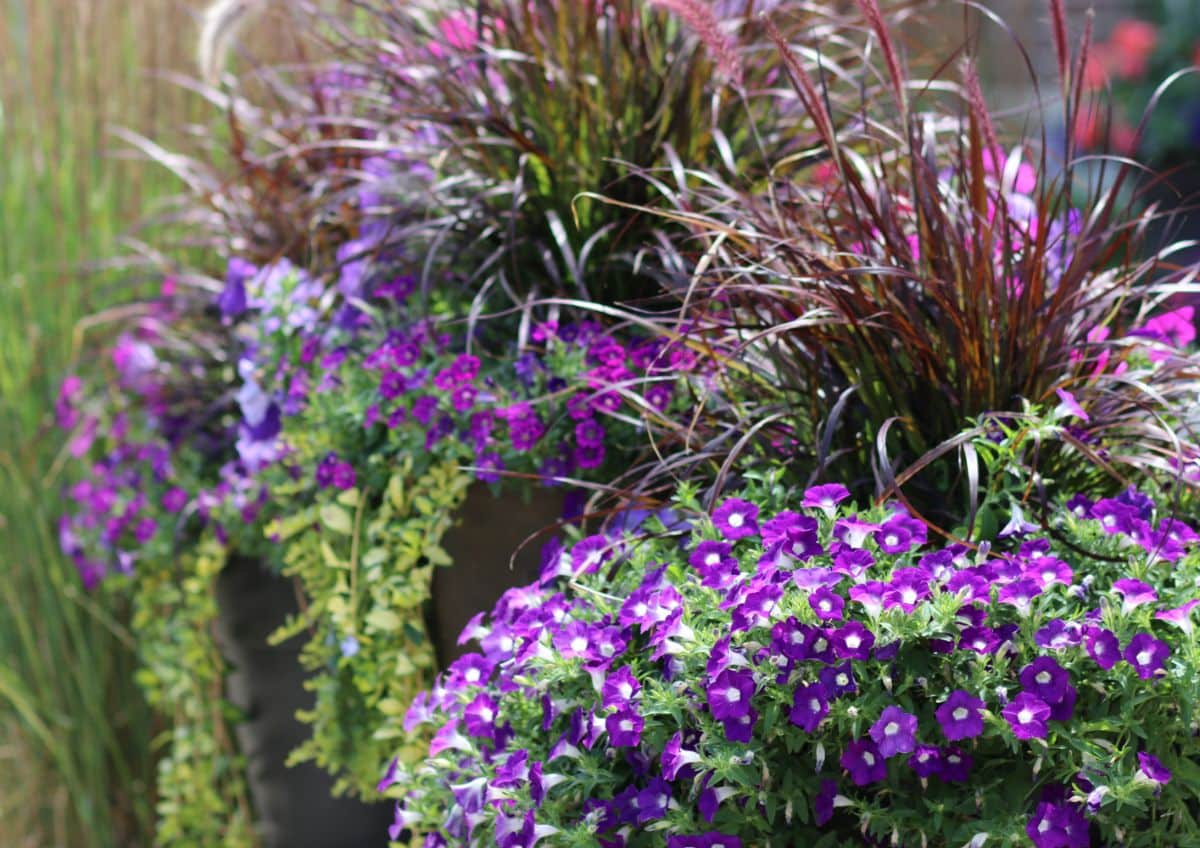
Thriller plants tend to be the largest plants in container gardens, and they usually feature strong lines or colorful leaves and flowers. Both foliage and flowering plants can be thrillers, and these plants are usually the tallest plants in containers, adding vertical interest and a pop of color too. Locate thriller plants either at the center or towards the back of containers for the fullest impact.
1. Dracaena
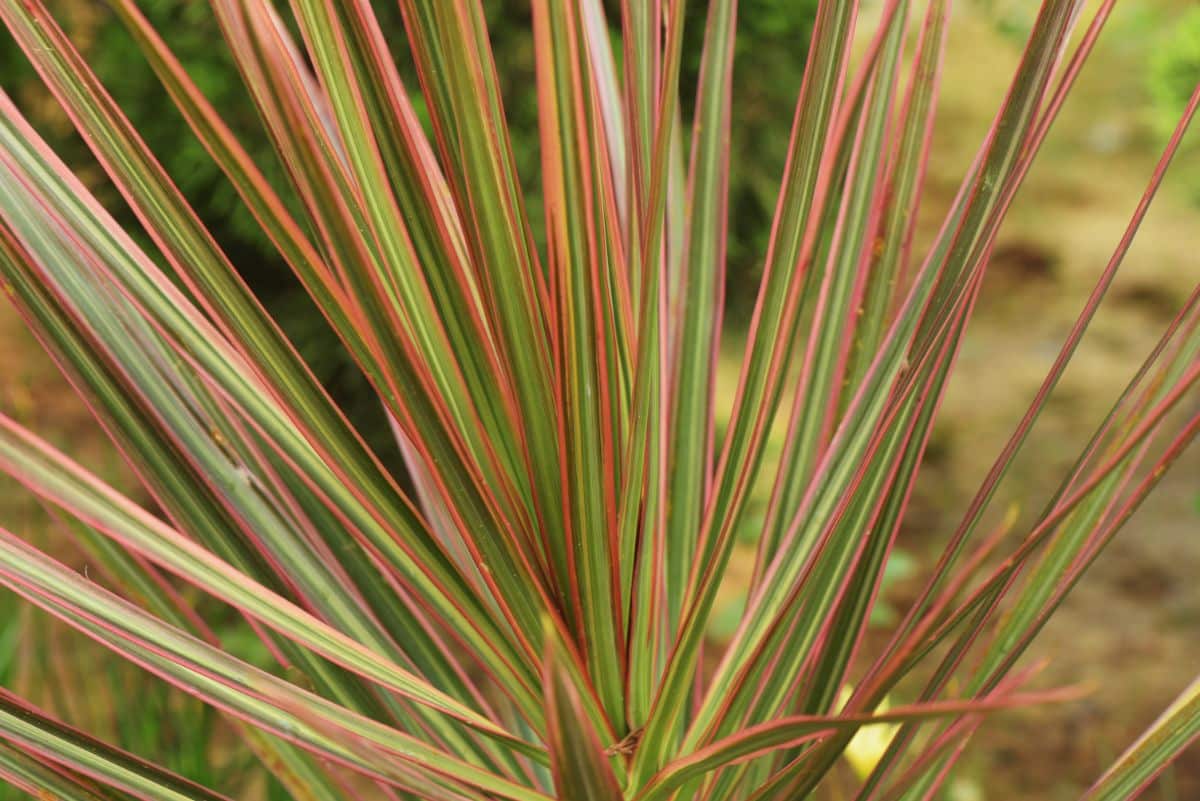
| Plant name: | Dracaena |
| Light requirements: | Bright, indirect light |
| Water requirements: | Moderate |
| Ornamental appeal: | Foliage |
Dracaena plants are popular additions to both indoor and outdoor plant displays. These undemanding plants are prized for their adaptability, as well as their strong lines and striking leaf colors. There are several different varieties of dracaena that are available at most plant nurseries, but a popular choice for container gardens is the dragon tree (Dracaenamarginata).
One of the best things about dracaena plants is that they can grow in medium to lower-light areas, which makes them suitable for keeping under covered porches or in shady patios. However, while these plants can adapt to different lighting conditions, they should be kept out of direct sun as they can suffer from leaf damage in bright light. Once autumn arrives, dracaena can be transferred indoors as a houseplant if you want to continue to enjoy your plant through the winter months!
2. Millet

| Plant name: | Millet |
| Light requirements: | Bright light |
| Water requirements: | Moderate |
| Ornamental appeal: | Seed heads |
Millet is commonly grown for its seed heads, which are edible for humans, and they also offer a protein-packed treat for wild birds. But millet is also a marvelous container plant, and its feathery sprays of seeds will add an interesting texture to any arrangement.
Most millet varieties grow between 1 and 4’ tall, making them suitable choices for containers. Pearl millet, however, is a larger plant and can reach up to 10’ high, so it’s not a top choice for smaller spaces. Millet comes in plenty of different colors, too, including the striking ‘Purple Majesty’ millet, which has leaves that are such a dark shade of purple they appear almost black!
3. Purple fountain grass
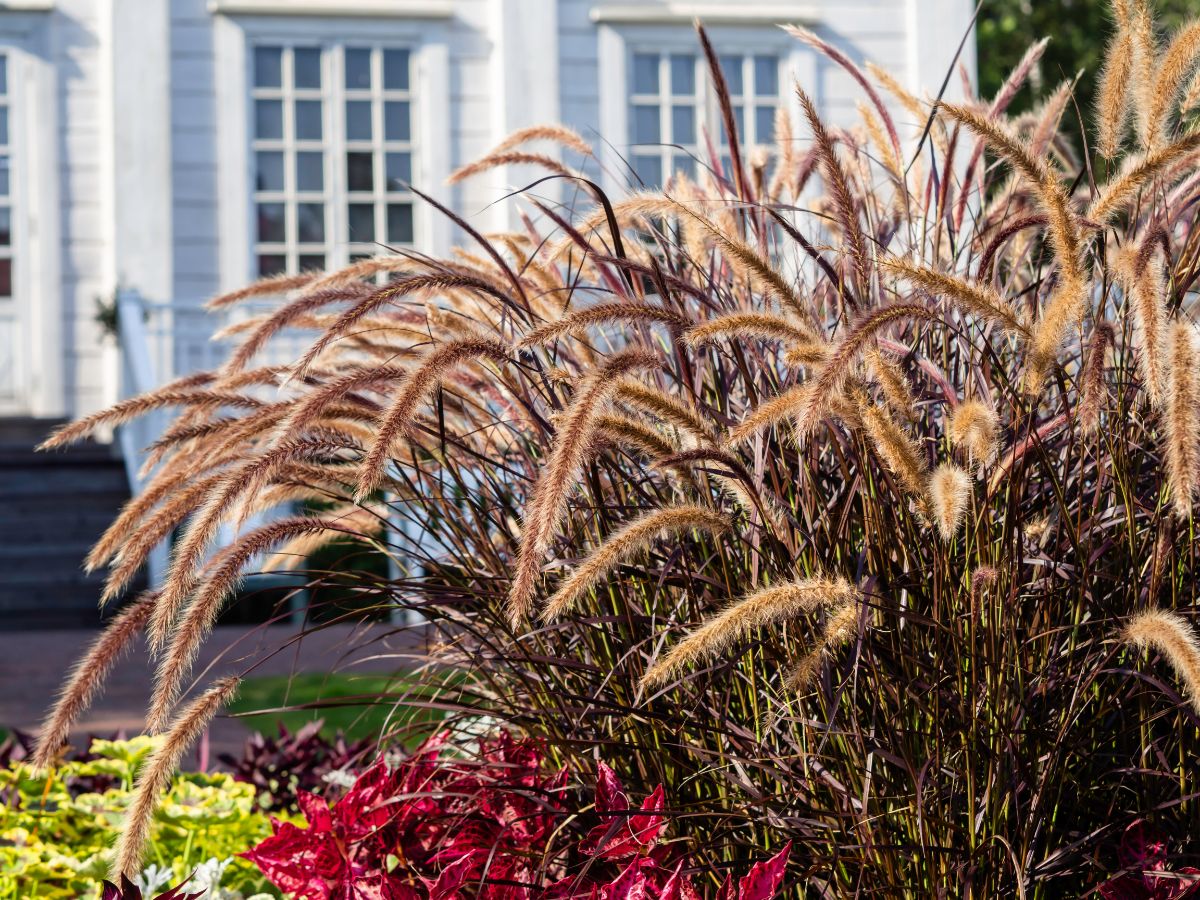
| Plant name: | Purple fountain grass |
| Light requirements: | Bright light to part shade |
| Water requirements: | Moderate |
| Ornamental appeal: | Seed heads |
Purple fountain grass is commonly grown in ornamental beds, but it also makes a fantastic and vivid addition to containers. This plant grows between 3 and 5’ tall, but there are dwarf cultivars that max out at around 18” in height. Plant purple fountain grass towards the back of your planter and delight in the fluffy seed heads that will form a delicate and arching backdrop to your lower-growing flowers and foliage plants.
4. Mums
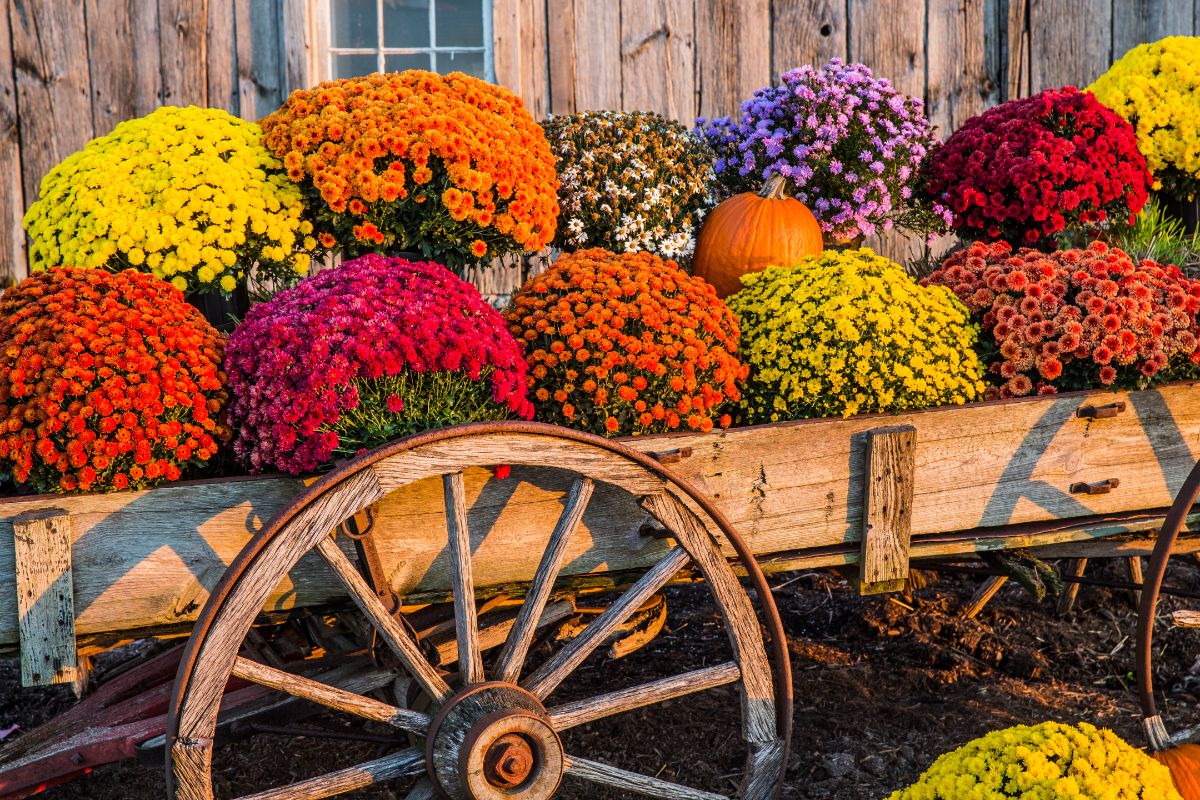
| Plant name: | Mums |
| Light requirements: | Bright light |
| Water requirements: | Moderate |
| Ornamental appeal: | Flowers |
A classic choice in autumn gardens, mums come in a veritable rainbow of hues, including purple, yellow, and orange. But while mums are mostly used as a seasonal plant in fall arrangements, some mum species can also flower in spring and summer. Pair mums with other colorful favorites, like Swiss chard, for a cool-weather planting design that will be the perfect centerpiece for your porch!
5. Cane begonias
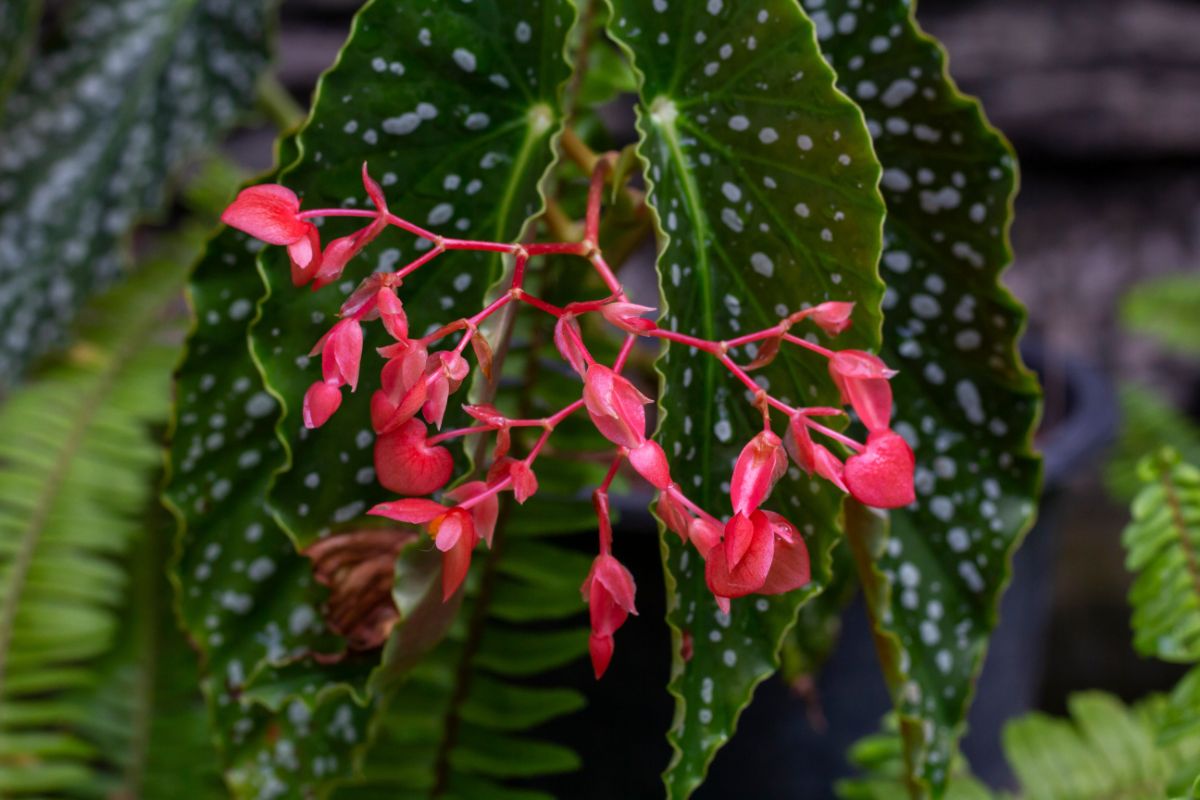
| Plant name: | Cane begonias |
| Light requirements: | Bright, indirect light |
| Water requirements: | Moderate |
| Ornamental appeal: | Flowers |
Begonias belong to a very diverse family of plants that includes over 2000 different species. Some begonias are suitable for filler or even spiller plants, but taller cane begonias make some of the most spectacular and stately thriller plants you can find.
Some of the best begonias to use as thrillers are ‘Polka dot’ or ‘Angel wing’ begonias (Begonia maculata). These begonia varieties grow up to 4’ high, and they have showy leaves that are patterned with hundreds of tiny polka dots!
6. Dwarf sunflowers
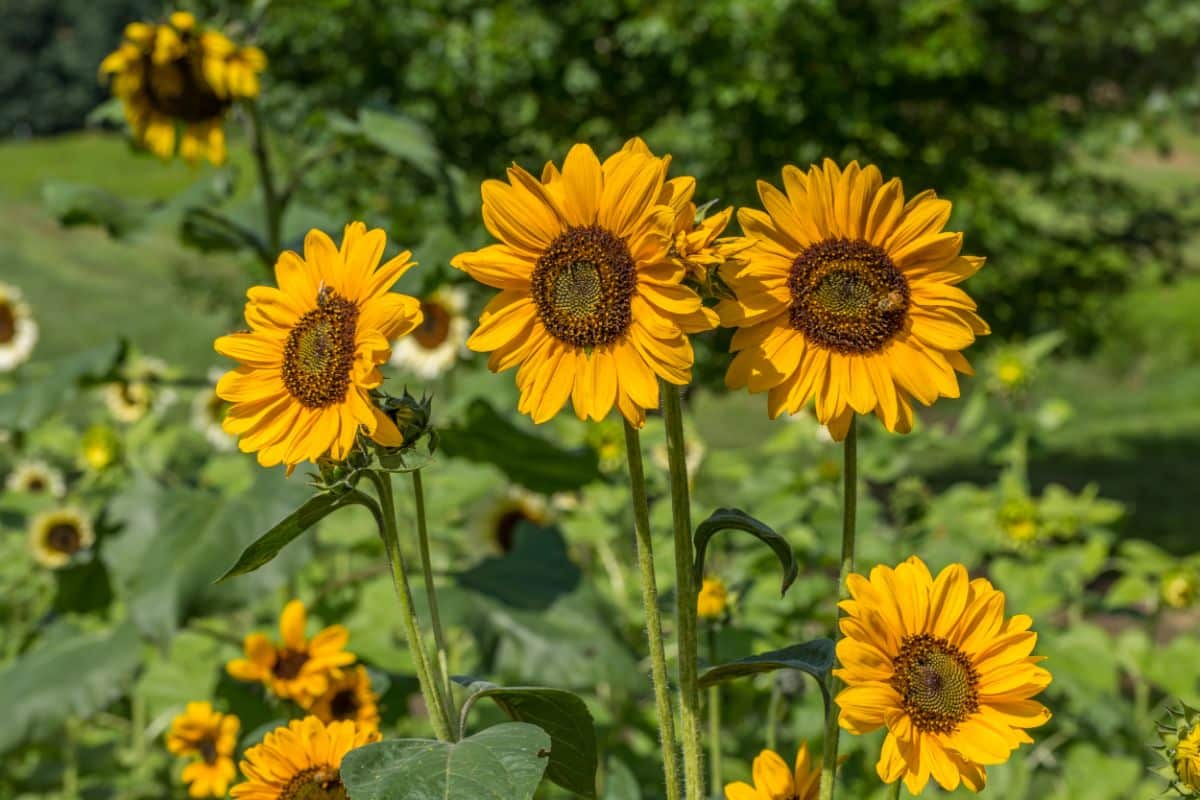
| Plant name: | Dwarf sunflowers |
| Light requirements: | Bright light |
| Water requirements: | Moderate |
| Ornamental appeal: | Flowers |
Most sunflowers are massive plants that are far too large for container gardens. However, if you grow dwarf sunflower varieties like ‘Dwarf Sunspot’ and ‘Teddy Bear,’ you can get all of the benefits of full-sized sunflowers but in a much smaller package.
Dwarf sunflowers generally grow between 2 and 3’ tall, although some varieties can stay under 1’ in height. Tiny but mighty dwarf sunflowers are highly attractive to pollinators like bees, and they make fabulous cut flowers too!
7. Dwarf hibiscus
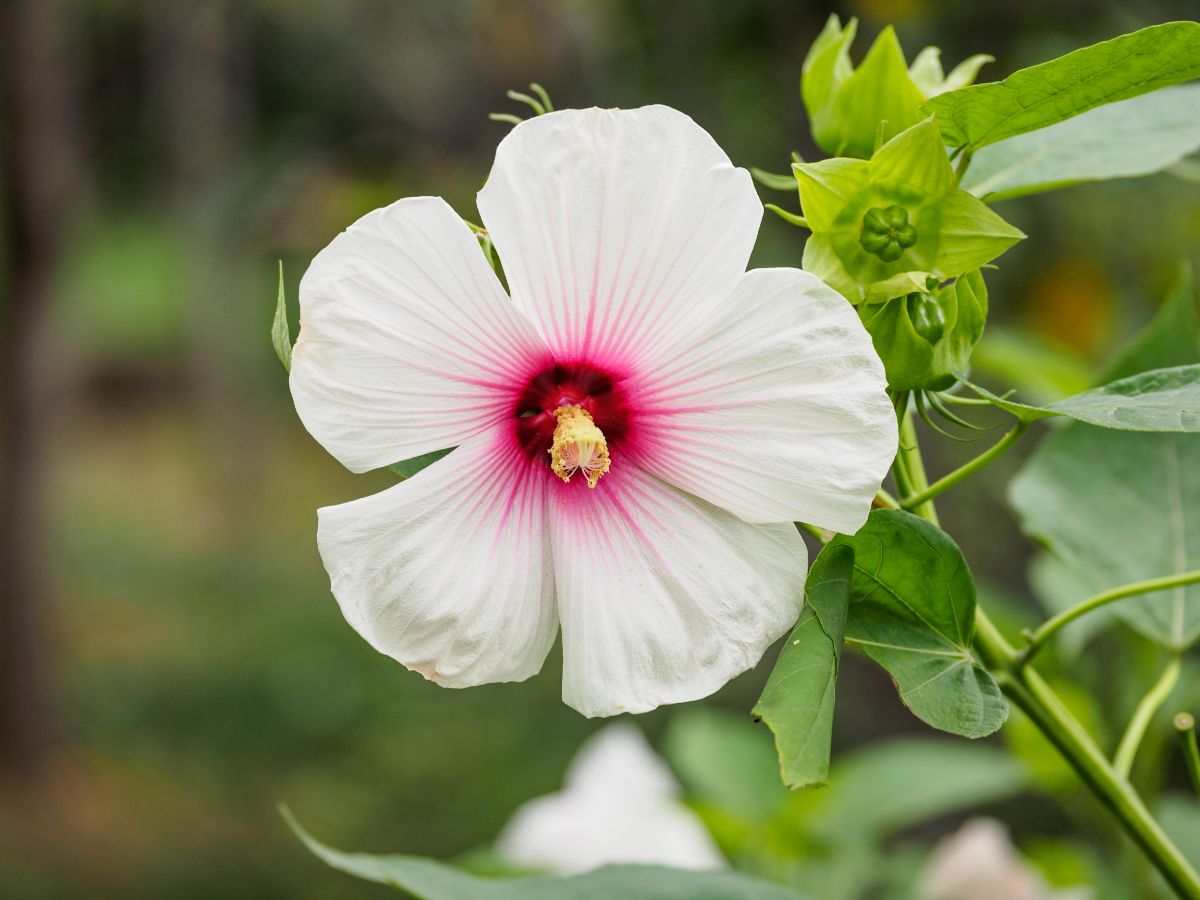
| Plant name: | Dwarf hibiscus |
| Light requirements: | Bright light |
| Water requirements: | Moderate |
| Ornamental appeal: | Flowers |
Like sunflowers, most hibiscus plants grow quite large; however, dwarf hibiscus plants only grow about 2 to 3’ tall. These plants are every bit as alluring as full-grown hibiscus plants, with their distinctly tropical blooms that come in almost every color you could want. Beyond their beauty, some hibiscus flowers are edible, and they can be added to a refreshing summer lemonade or baked into desserts and other sweet treats!
8. Mandevilla
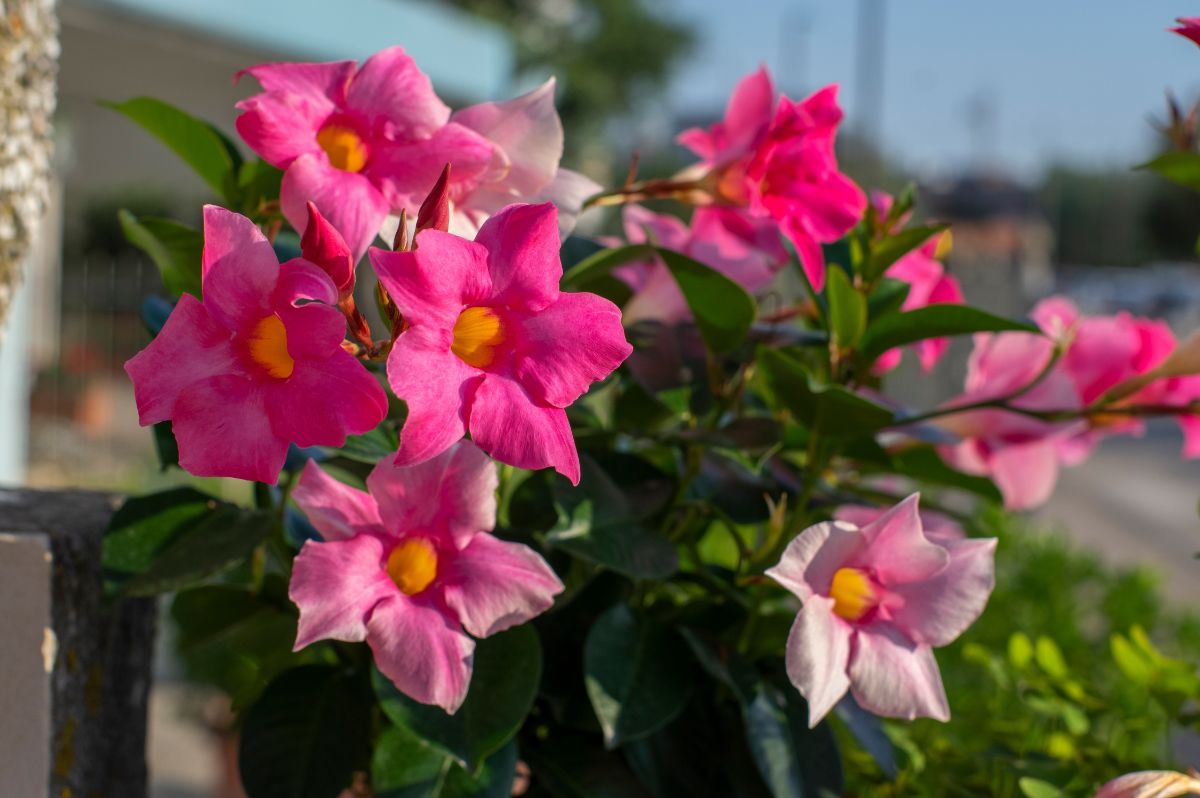
| Plant name: | Mandevilla |
| Light requirements: | Bright light |
| Water requirements: | Moderate |
| Ornamental appeal: | Flowers |
Also known as Dipladenia or the rock trumpet, mandevilla plants have been cultivated since at least the 1840s, but they are native to the Americas. These flamboyant plants feature flashy flowers in red, pink, or white, which are highly attractive to hummingbirds, as well as other pollinators. While mandevilla grows perennially in zones 10 and 11, it is kept as an annual in cooler spots, and it’s sure to be the star of any container garden.
9. Canna lily

| Plant name: | Canna lily |
| Light requirements: | Bright light to part shade |
| Water requirements: | Moderate |
| Ornamental appeal: | Flowers |
Canna lilies are another bold plant choice, which will add a lavish and tropical feel to planters, especially when paired with other colorful plants like fuchsia and heliotropes. Growing as perennials from zones 8 to 11, canna lilies are mostly kept as annuals in cooler regions. However, you can dig up canna lily rhizomes in the fall and overwinter them indoors if you want to keep your plants going.
Canna lilies are famous for their bright flowers that come in various shades of orange, yellow, white, and pink, but you can also enjoy canna lilies as foliage plants. Some cannas have striped foliage that can add an interesting layer to potted arrangements, and canna lily flowers are also ideal for bouquet-making!
10. Caladium
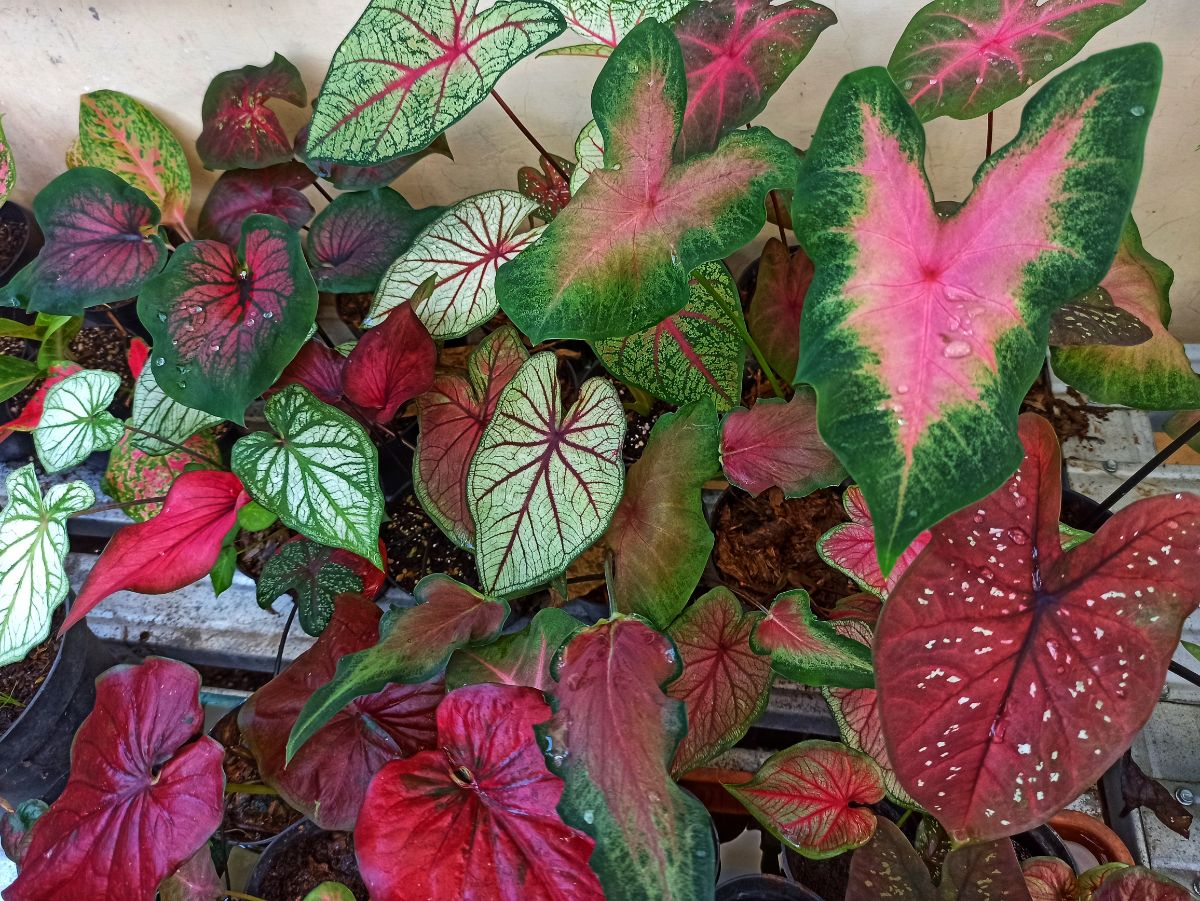
| Plant name: | Caladium |
| Light requirements: | Bright, indirect light |
| Water requirements: | Moderate |
| Ornamental appeal: | Foliage |
Like dracaena, caladiums are often grown indoors as houseplants, but they are also a prime choice for container planters. Caladiums are some of the best foliage plants you can keep, thanks to their thin leaves, which are so sheer they can allow light to shine right through! Caladium leaves come in many different colors, including red and white, but the showiest options have multi-colored leaves.
When fall begins, you can overwinter your caladiums indoors as houseplants, or you can keep them as annuals only. Just be aware that if you bring caladiums indoors, their leaves are toxic to pets.
Fillers
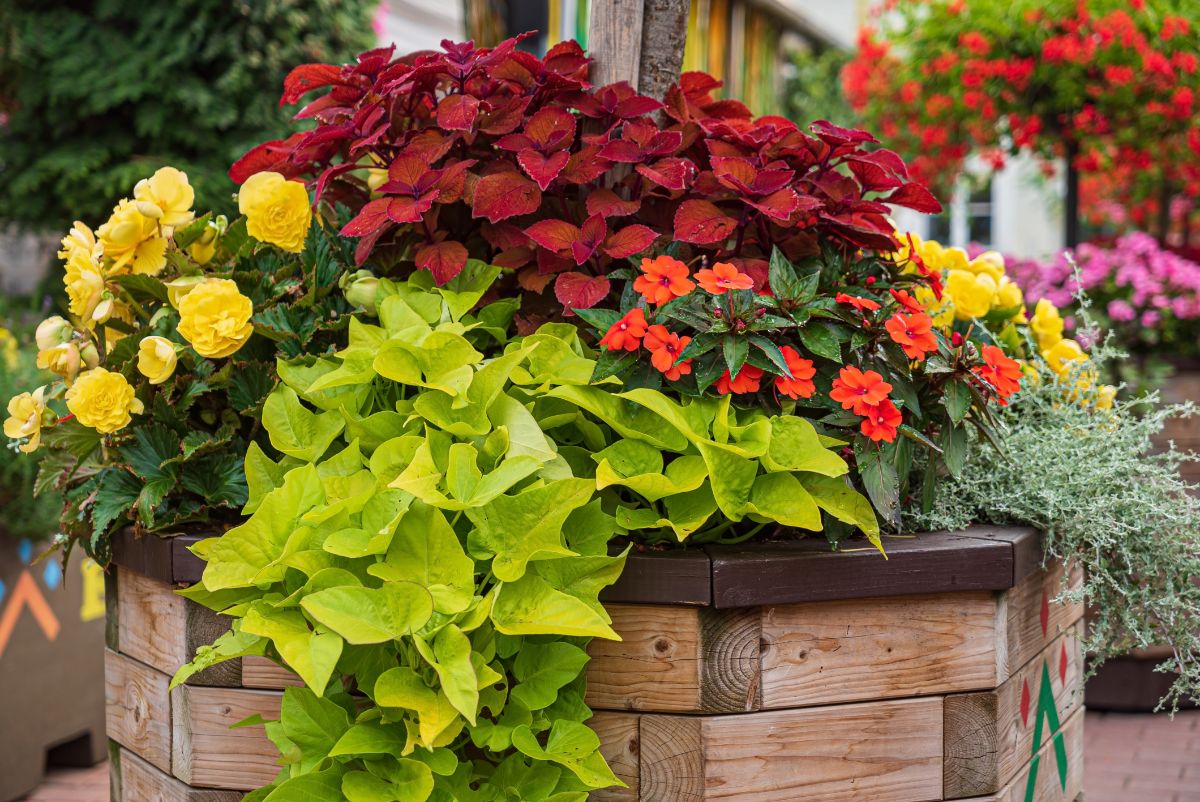
Filler plants are usually a bit smaller than thrillers, but they can be just as flashy with colorful leaves and flowers or interesting silhouettes. Filler plants often have mounded forms and bushier leaves to fill up empty space in your containers and give planters a more finished look. Often filler plants are either the same color as thriller plants, or they may come in a shade that complements the thriller plant.
1. Corkscrew rush
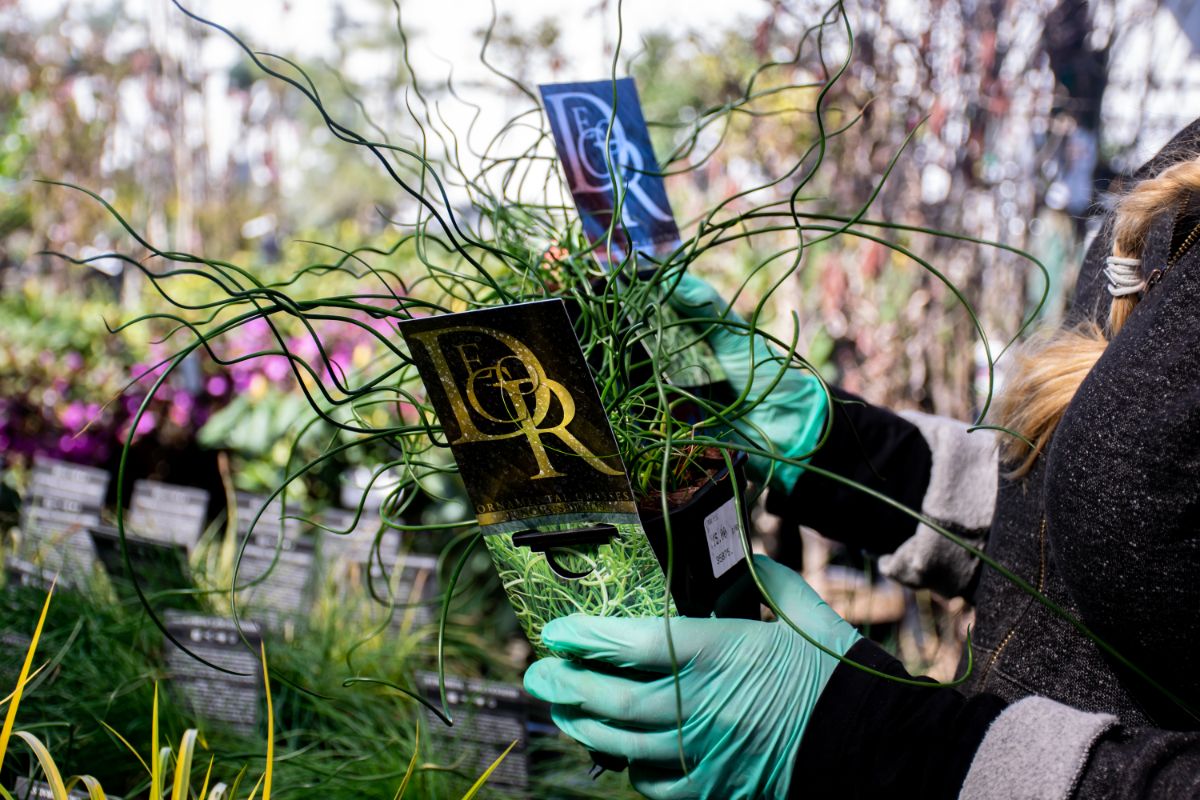
| Plant name: | Corkscrew rush |
| Light requirements: | Bright light to part shade |
| Water requirements: | High |
| Ornamental appeal: | Foliage |
Corkscrew rush is a funky plant with slightly wavy and curled leaves that can add interesting lines to your container garden. Many rushes naturally grow in wetland areas, and as a result, they prefer moist soil. Corkscrew rush is no exception to this rule, so be sure to water your planter often if you want to keep corkscrew rushes looking their best!
2. Dusty miller
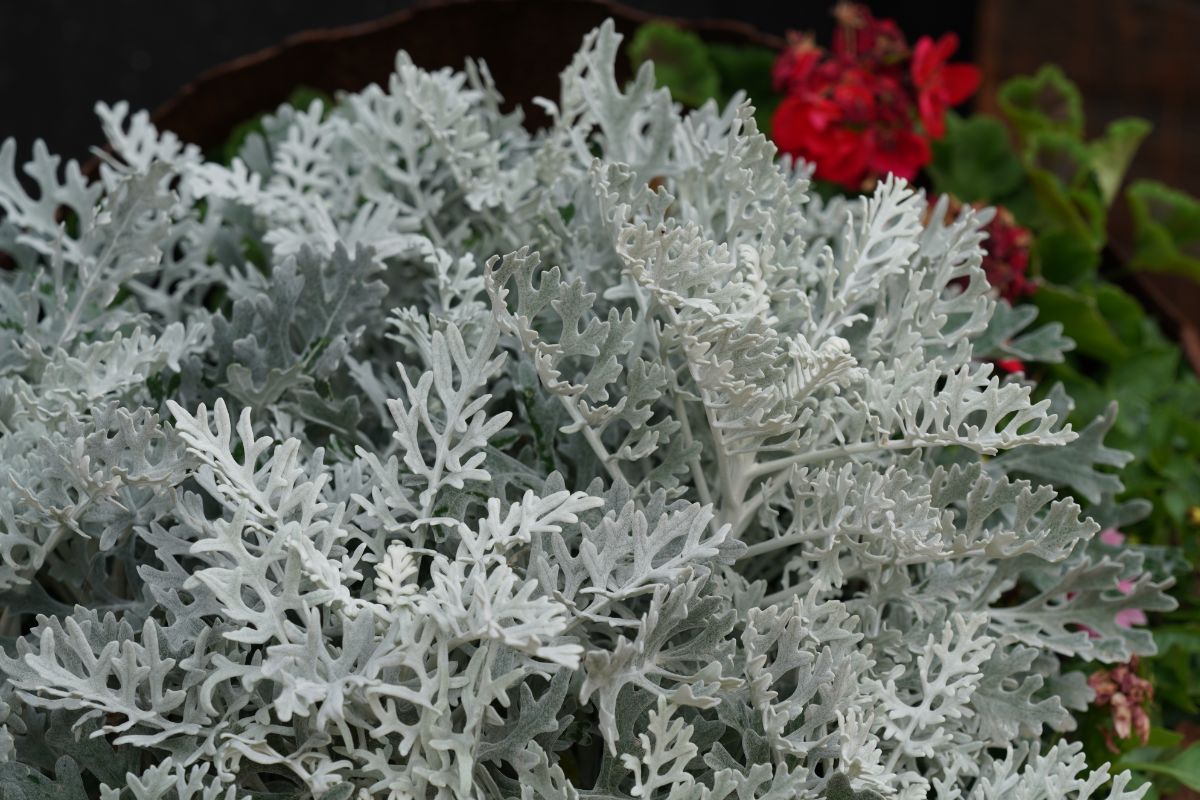
| Plant name: | Dusty miller |
| Light requirements: | Bright light to part shade |
| Water requirements: | Moderate |
| Ornamental appeal: | Foliage |
Dusty miller is a classic choice for container gardens, and it’s often paired with other traditional container plants, like petunias and creeping Jenny. Named for its silvery leaves, dusty miller adds a light and airy quality to container arrangements, and it even shows up well after dark thanks to its bright foliage. In zones 7 to 10, dusty miller grows as a perennial, and it will usually bloom in its second year; however, in colder regions, dusty miller is kept as an annual.
3. Pentas
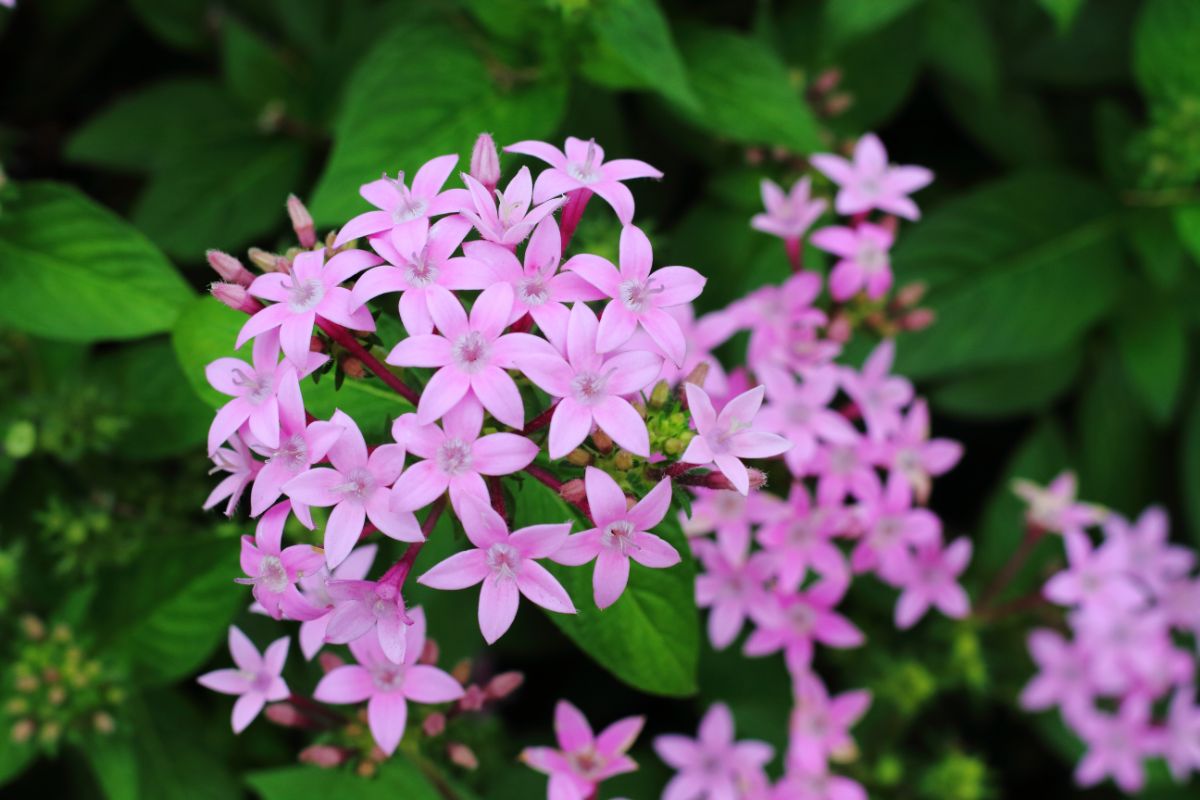
| Plant name: | Pentas |
| Light requirements: | Bright light |
| Water requirements: | High |
| Ornamental appeal: | Flowers |
Also known as Egyptian stars, pentas have star-shaped flowers that are always a magnet for butterflies and hummingbirds. Like a little jewel in your planters, pentas come alive in summer with brilliant flowers in pinks, reds, purples, and white. Pentas are heat-loving plants, but they don’t handle the cold well, and they only grow as annuals in growing zones 9 and below.
4. Petunias
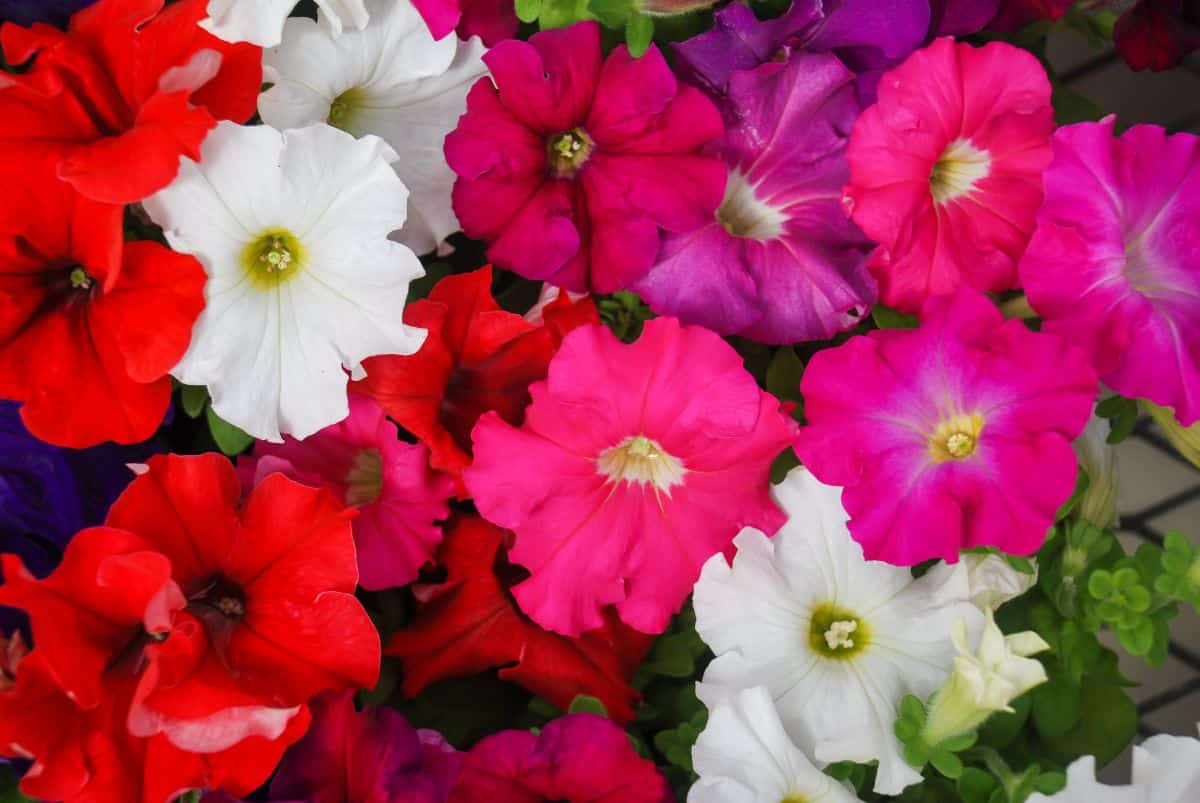
| Plant name: | Petunias |
| Light requirements: | Bright light |
| Water requirements: | Moderate |
| Ornamental appeal: | Flowers |
No container garden would be complete without petunias. These classic plants are often used in hanging baskets, but they can be grown as fillers in patio planters and front porch display too. You can find petunias’ trumpet-shaped flowers in almost every color you could want, but the flashiest flowers have multiple colors in each bloom.
Petunias are usually grown as annuals, but they can handle cold quite well. Some petunias are even frost-hardy, allowing you to grow these plants in spring and fall. You can also extend your petunia bloom time by covering your plants up with plant covers or a lightweight sheet when frost is expected.
5. Coleus
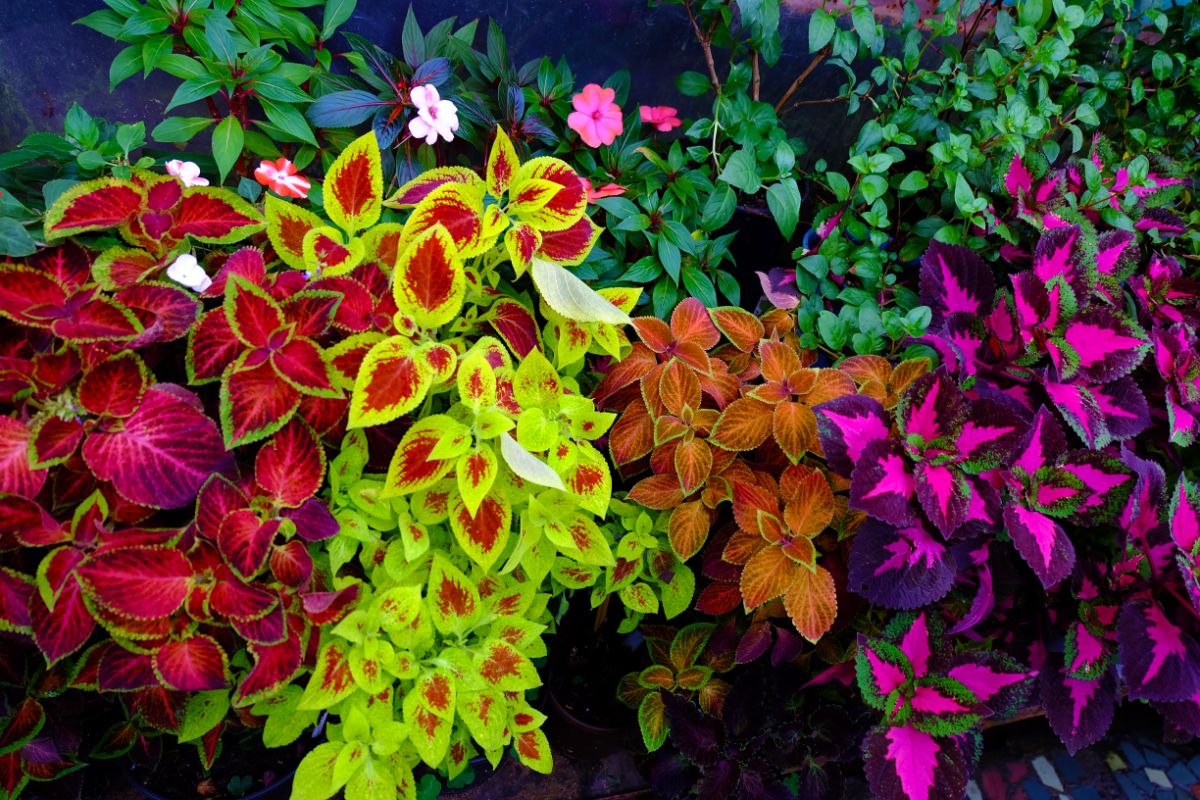
| Plant name: | Coleus |
| Light requirements: | Bright, indirect light |
| Water requirements: | Moderate |
| Ornamental appeal: | Foliage |
Coleus is a highly coveted foliage plant that can be grown indoors or out, depending on your interests. As a houseplant, coleus needs extra humidity, but it is much less demanding in an outdoor container garden. Pair coleus’ colorful leaves with other autumn favorites, like mums or Swiss chard, for a truly eye-catching container garden that can’t help but impress.
6. Swiss chard
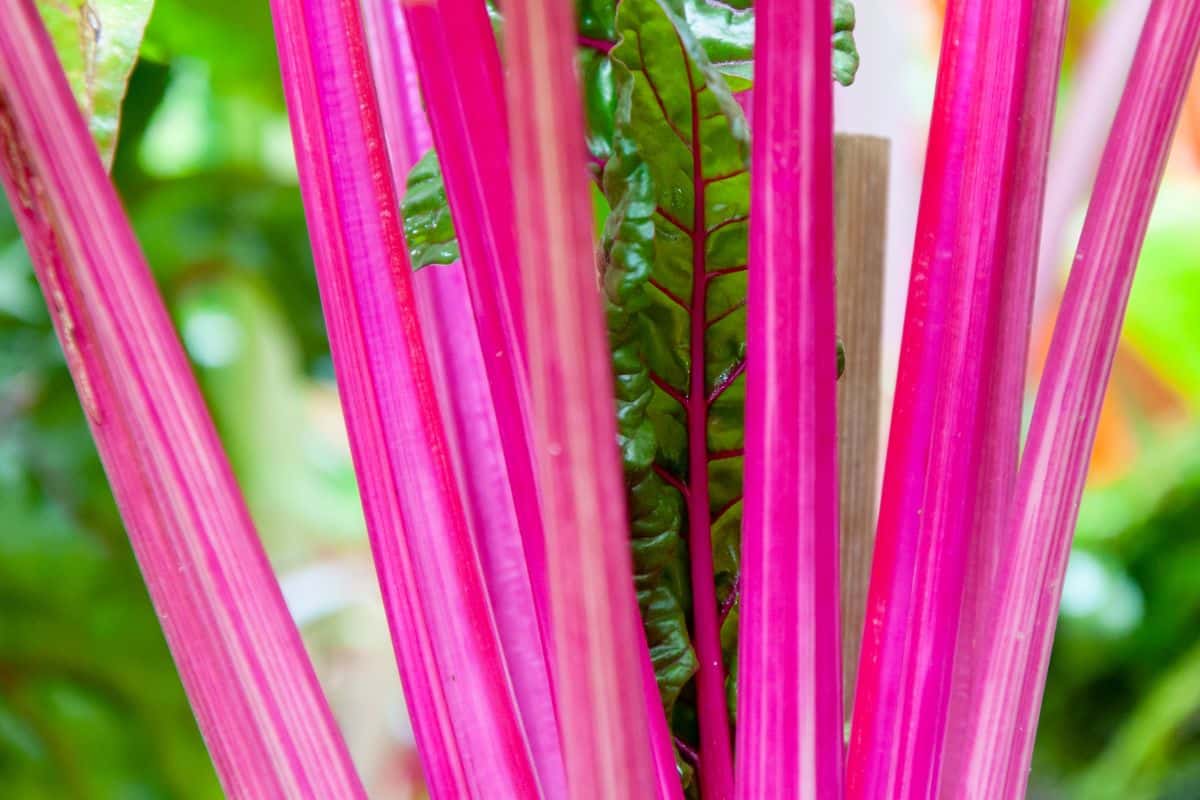
| Plant name: | Swiss chard |
| Light requirements: | Bright light to part shade |
| Water requirements: | Moderate |
| Ornamental appeal: | Stems |
Most of us think of Swiss chard as an edible leafy green that has no business outside of the vegetable garden. However, most Swiss chard varieties have brightly colored ribs, which have tons of ornamental appeal.
While you can try out various types of Swiss chard in your container garden, you can also plant ‘Rainbow Blend’ seeds and get Swiss chard plants with red, yellow, and pink ribs. Beyond being attractive to the eye, Swiss chard is also edible. That means that when you’re done enjoying your Swiss chard plants as ornamentals, you can harvest them and cook them up with your favorite meal!
7. Impatiens
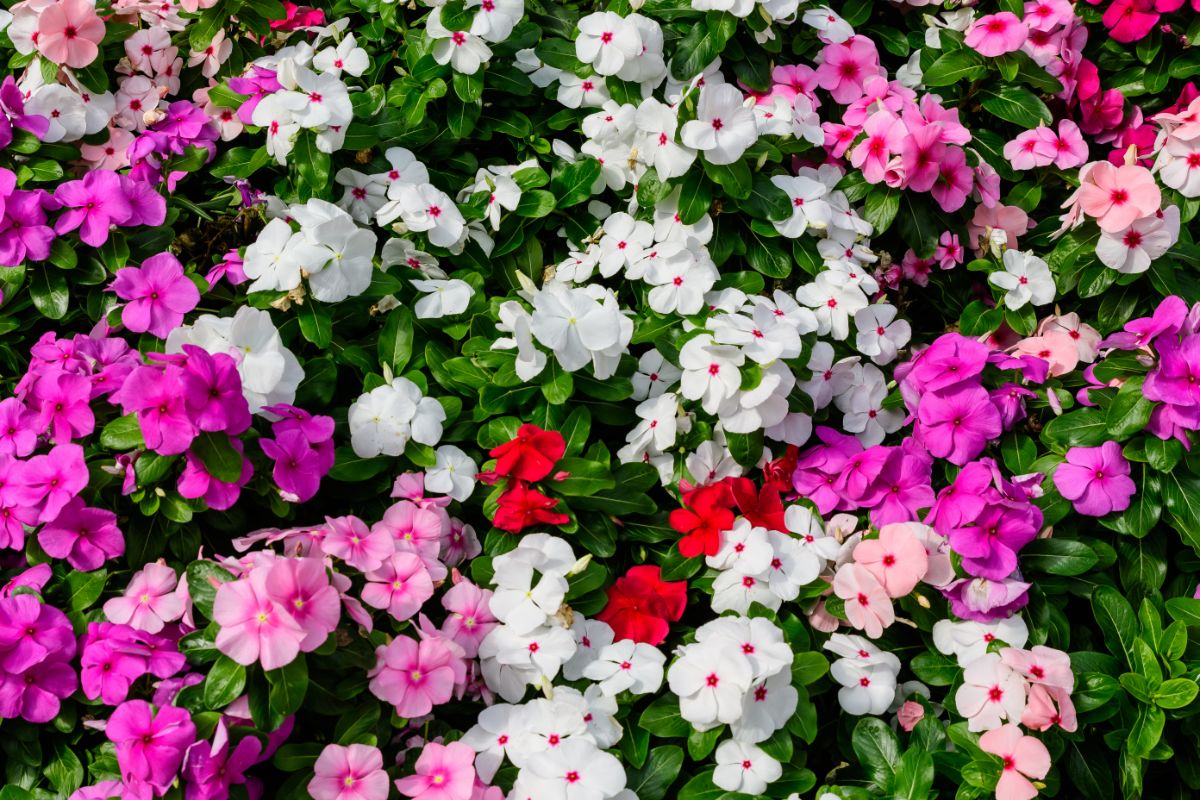
| Plant name: | Impatiens |
| Light requirements: | Part shade |
| Water requirements: | High |
| Ornamental appeal: | Flowers |
Pretty as a picture, impatiens are another popular choice for container gardens as they are very low maintenance. These adaptable plants grow best in part shade, allowing you to keep them under covered porches or in other lower-light areas. Impatiens flowers come in a wide variety of colors, and you can now find impatiens with newly developed yellow blooms too!
8. Begonias

| Plant name: | Other begonias |
| Light requirements: | Bright, indirect light |
| Water requirements: | Moderate |
| Ornamental appeal: | Flowers |
While taller cane begonias make phenomenal thriller plants in container gardens, begonias come in many different sizes, and some of the shorter begonia cultivars are ideal filler flowers. You can try out different begonias in your planter, but you may want to seek out rex begonias, as they have some of the most colorful leaves you can find. Even better, rex begonias also grow beautifully indoors, so you can transplant your begonias into indoor pots in winter if you want to!
9. Herbs
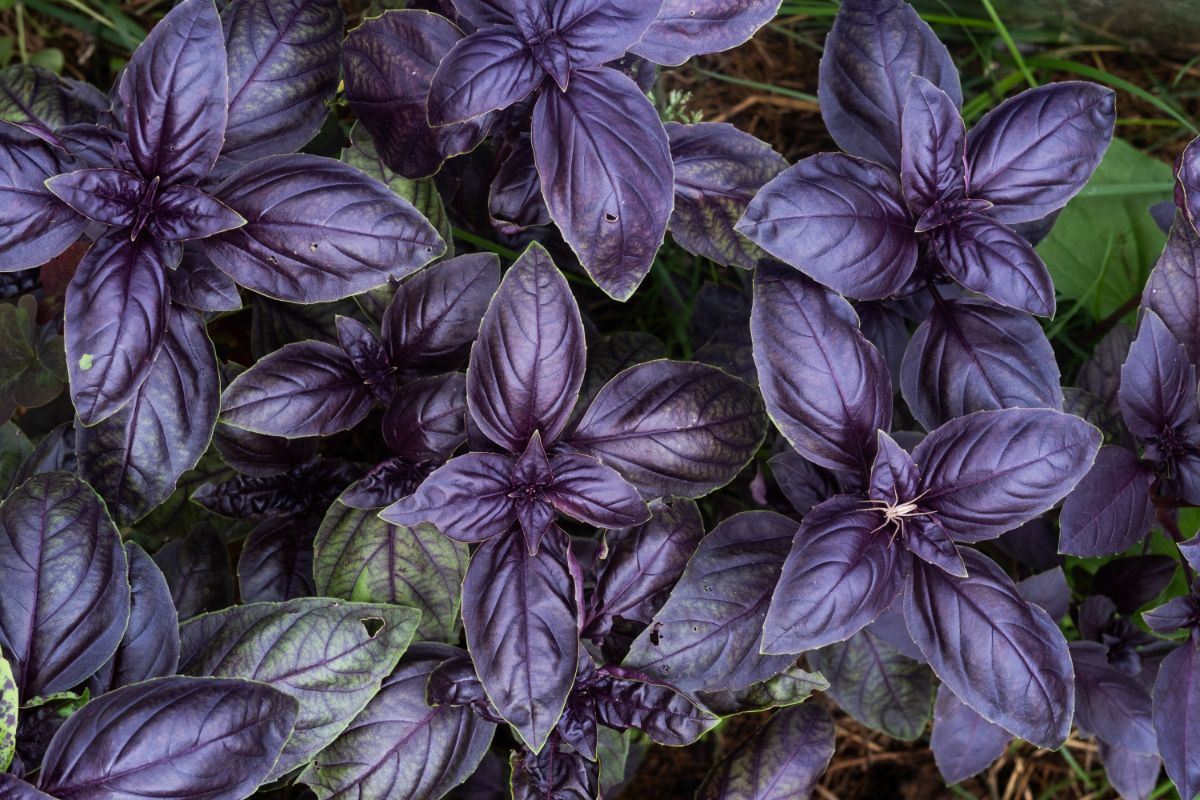
| Plant name: | Herbs |
| Light requirements: | Bright light to part shade, depending on the species |
| Water requirements: | Moderate to low, depending on the species |
| Ornamental appeal: | Foliage and flowers |
If you like the idea of keeping edible plants like Swiss chard and sunflowers in your container garden, you may also want to grow herbs as filler plants too! Many herbs, like thyme and oregano, produce pretty, pinkish-purple flowers that are irresistible to bees and other pollinators. However, you can also grow herbs like purple basil purely for their ornamental leaves.
10. Heliotropes
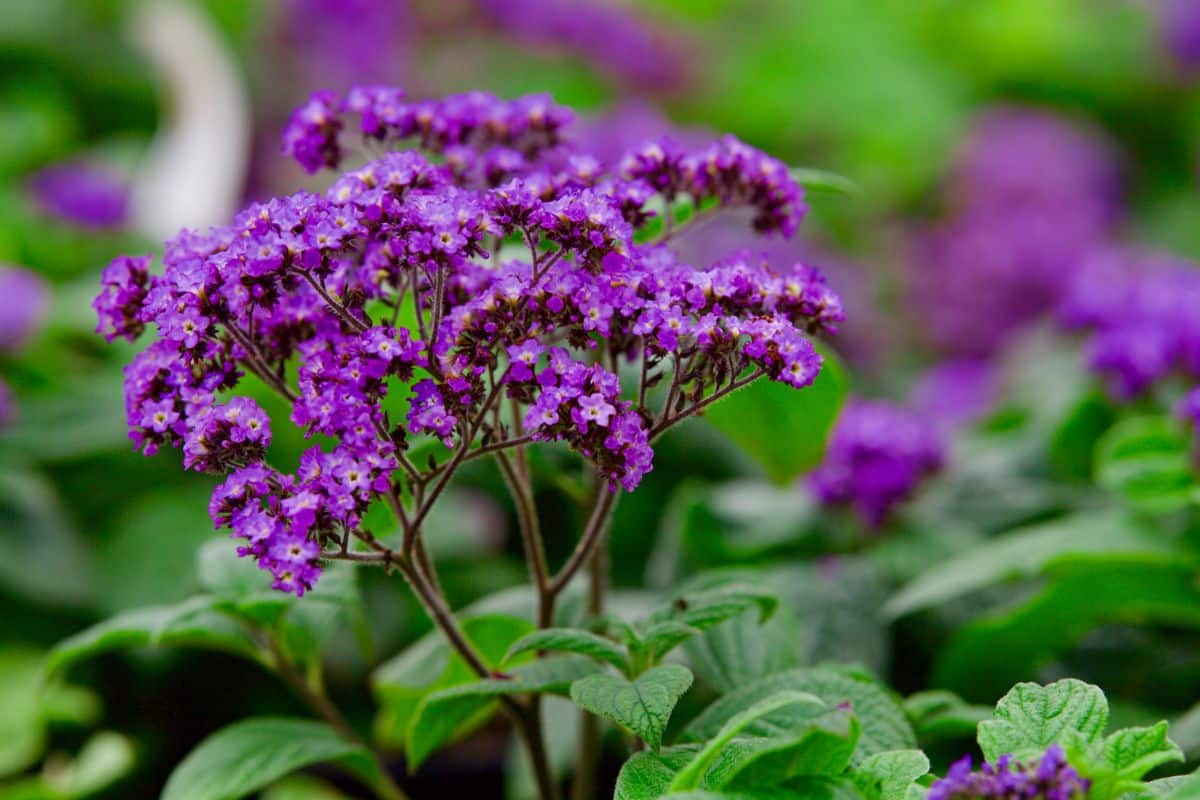
| Plant name: | Heliotropes |
| Light requirements: | Bright light |
| Water requirements: | High |
| Ornamental appeal: | Flowers |
Heliotropes are often used in potpourri blends due to their fine fragrance, which has notes of vanilla and almond. But these plants are even more alluring when fresh, as they will enliven your container garden with their rich aroma. Like sunflowers, heliotrope flowers move with the sun, so don’t be surprised if your flowers are pointing in a different direction in the morning and the evening!
Spillers
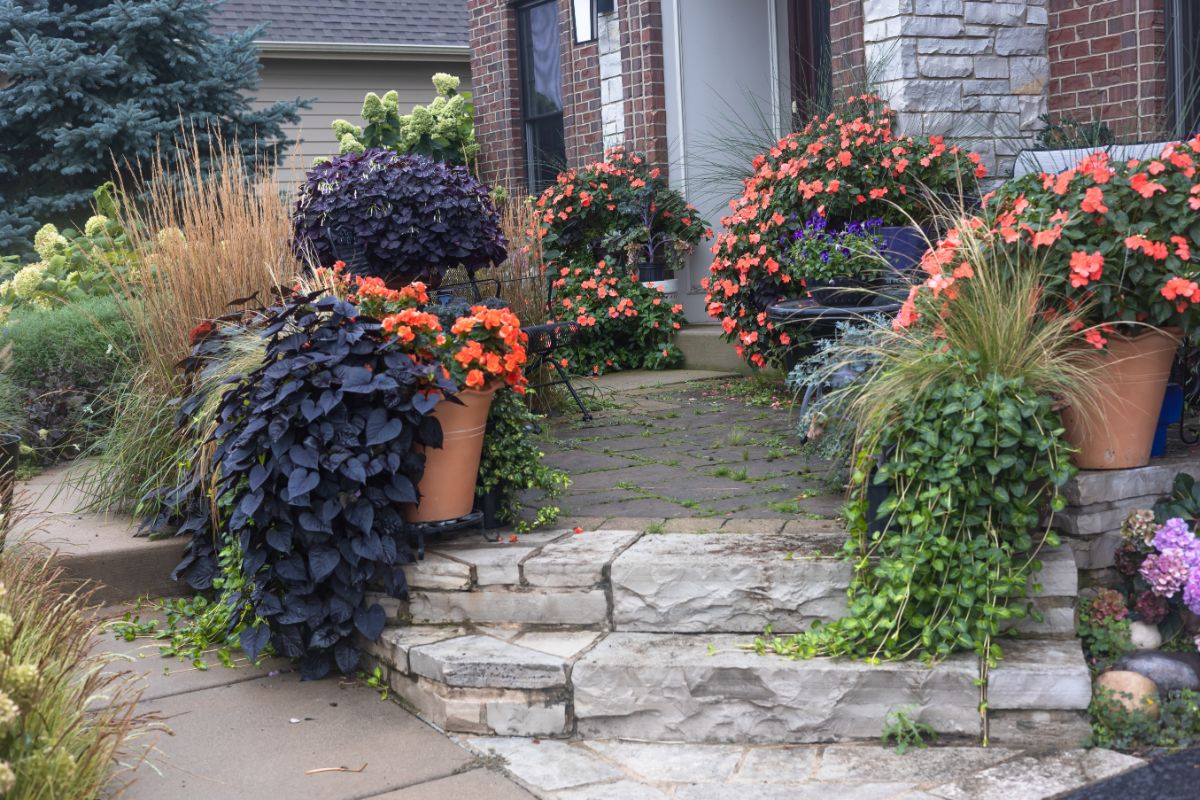
Spiller plants are usually trailing or vining plants that spill over the edge of container gardens. This adds more movement to planting arrangements and a complex look that helps to make container planters part of the landscape around them. Spillers may flower, or they may just be kept for their uniquely shaped leaves and color.
1. Sweet potato vine
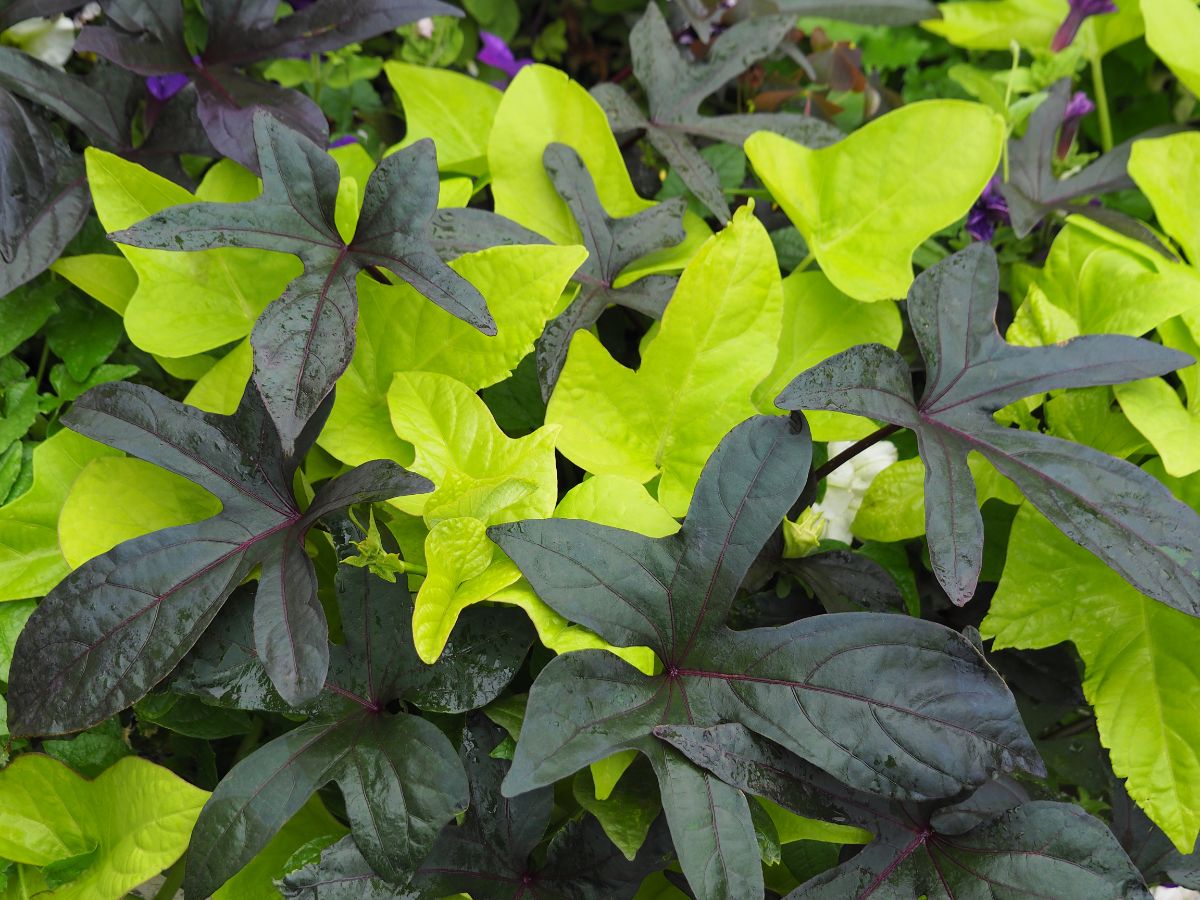
| Plant name: | Sweet potato vine |
| Light requirements: | Bright light |
| Water requirements: | Moderate |
| Ornamental appeal: | Foliage and flowers |
Sweet potato vine is generally grown as an ornamental, although it is technically the same plant as edible sweet potatoes! While these plants will produce edible tubers, sweet potatoes from ornamental vines are usually smaller and less flavorful than sweet potatoes intended for garden growing. As potted plants, sweet potato vines are ideal for adding more vertical interest, and their long, cascading stems can help tie your container garden into the surrounding environment.
Sweet potato vines usually come in two main colors: chartreuse green and dark purple. These plants are actually closely related to morning glories, and they can produce large, trumpet-shaped flowers too. Like many other container garden plants, sweet potato vines also make fabulous houseplants!
2. Creeping Jenny
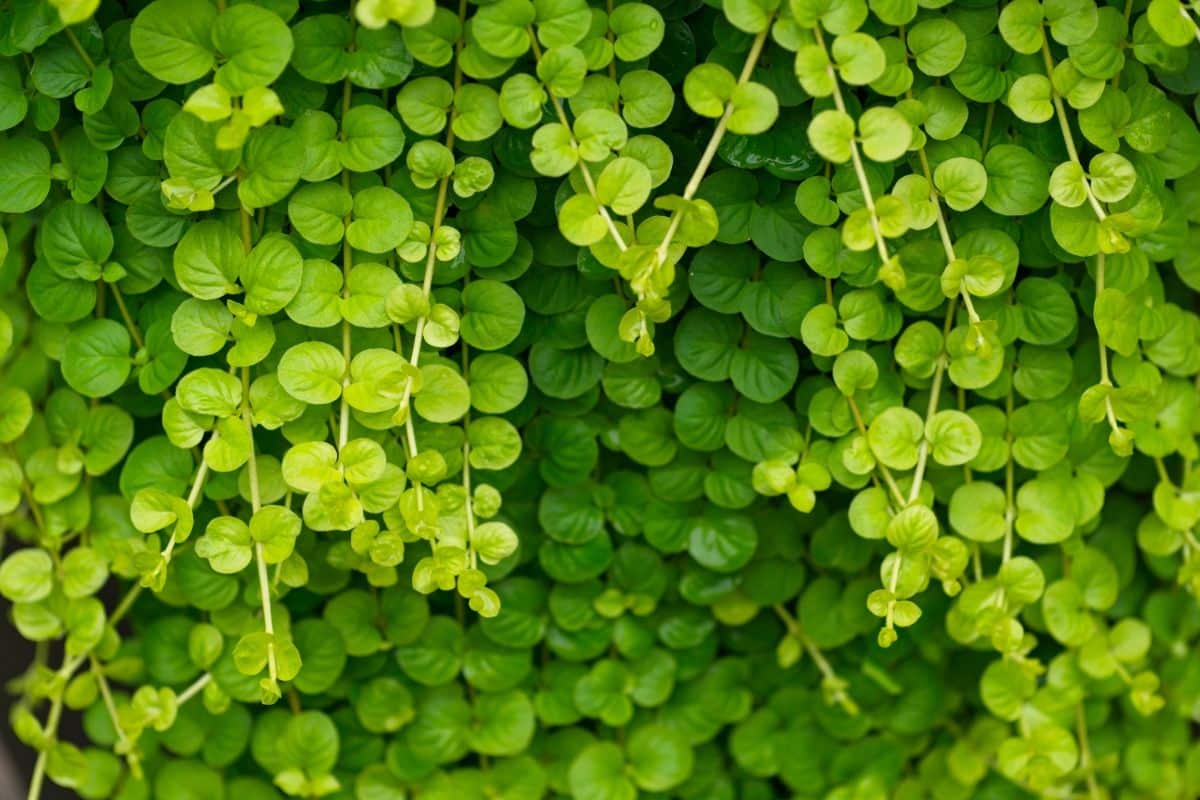
| Plant name: | Creeping Jenny |
| Light requirements: | Bright light to part shade |
| Water requirements: | High |
| Ornamental appeal: | Foliage and flowers |
Creeping Jenny is another brilliant spiller plant with chartreuse green leaves that are truly attention-getters. When grown in containers, creeping Jenny can highlight more subtly colored plants like millet, or it can be grown with other bold plant choices, like hibiscus or canna lilies. As a moisture lover, creeping Jenny does need regular watering, and you should never allow the soil to dry out completely if you want to keep these plants happy.
3. Sweet alyssum
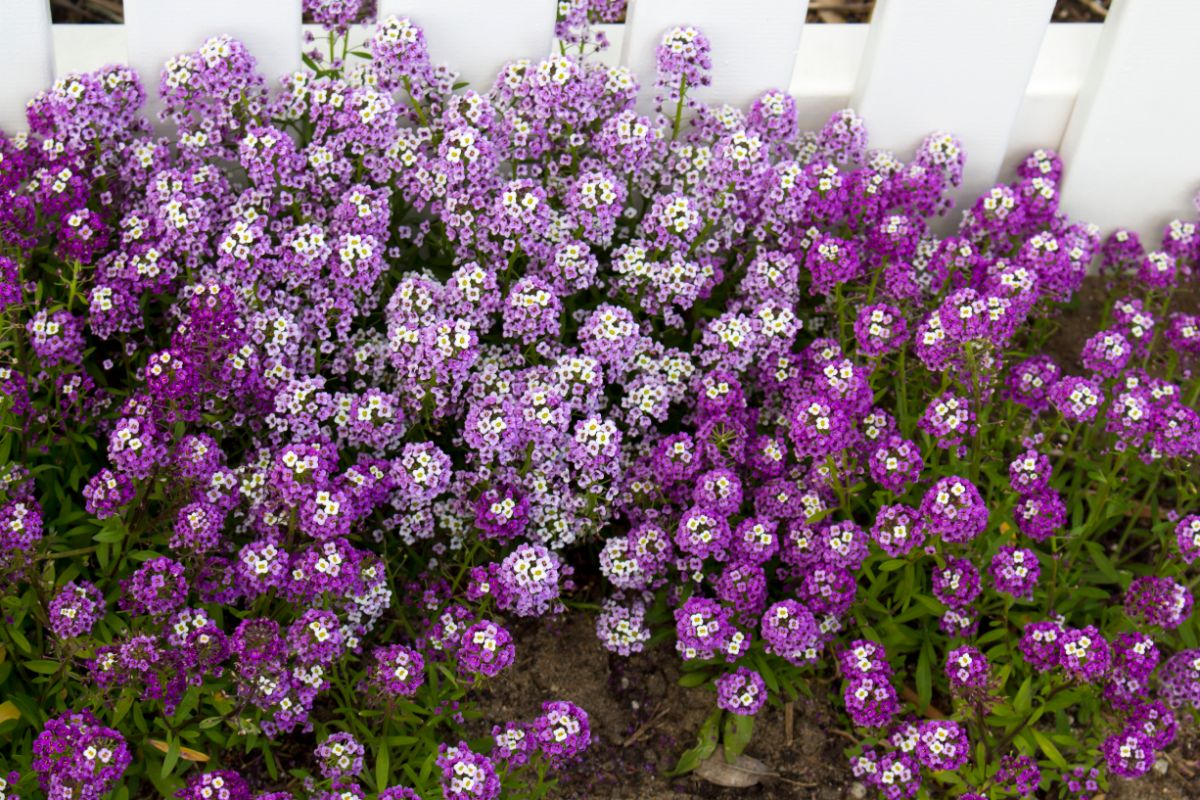
| Plant name: | Sweet alyssum |
| Light requirements: | Bright light to part shade |
| Water requirements: | Moderate |
| Ornamental appeal: | Flowers |
Sweet alyssum is a fantastic companion plant in vegetable gardens because its sweetly scented flowers are irresistible to beneficial insects like predatory wasps. However, this multipurpose plant is also ideal for container growing, and even with minimal upkeep, it will reward you with a colorful display of purple and white flowers. While hardy, sweet alyssum doesn’t like the heat much, it will usually stop flowering when temperatures rise in summer and resume blooming in fall.
4. Inchplants
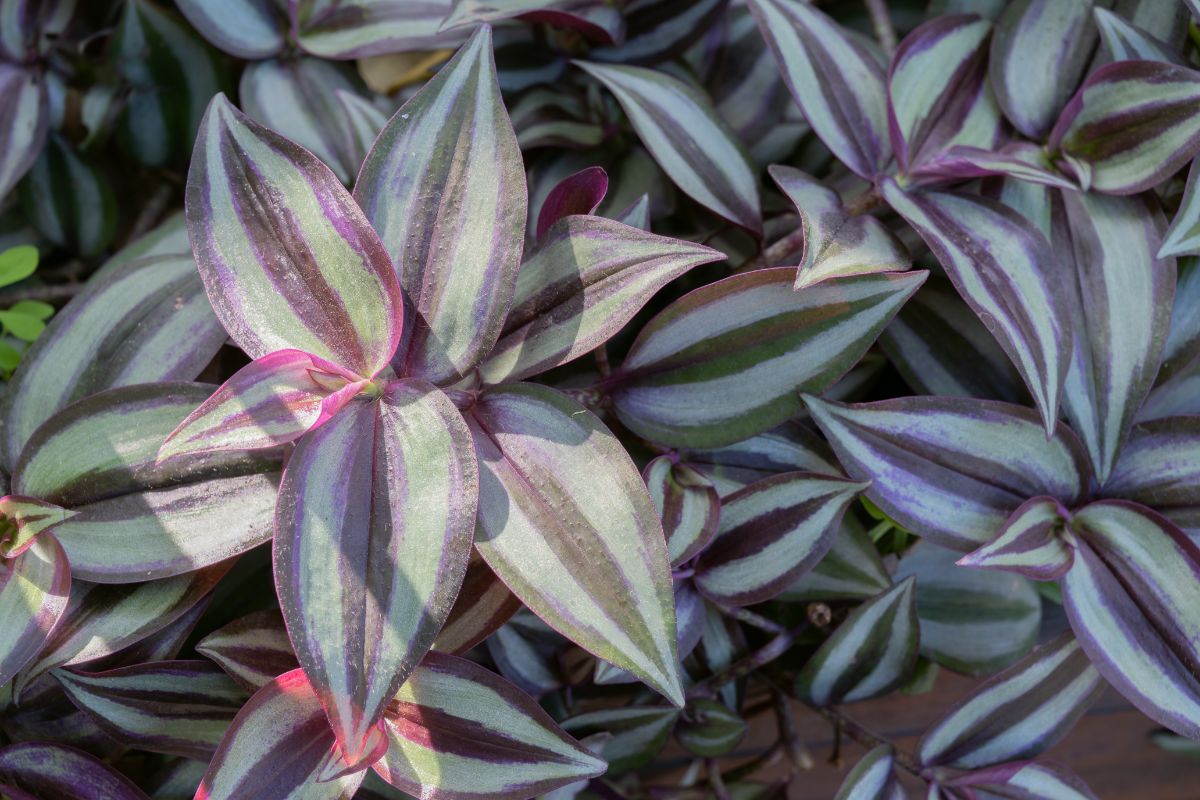
| Plant name: | Inchplants |
| Light requirements: | Bright, indirect light |
| Water requirements: | Moderate |
| Ornamental appeal: | Foliage |
Inchplants are often grown as houseplants, but they are adaptable enough for outdoor container gardens too. These trailing plants have fleshy, semi-succulent stems, which trail gracefully over pot margins. You can find inchplants in either green or purple, but both varieties have interesting, striped leaves with a slightly silvery sheen.
If you love your inchplant, feel free to bring it indoors in autumn. These plants are perfect for hanging baskets, and they’re super easy to propagate in water too!
5. Ivy geranium
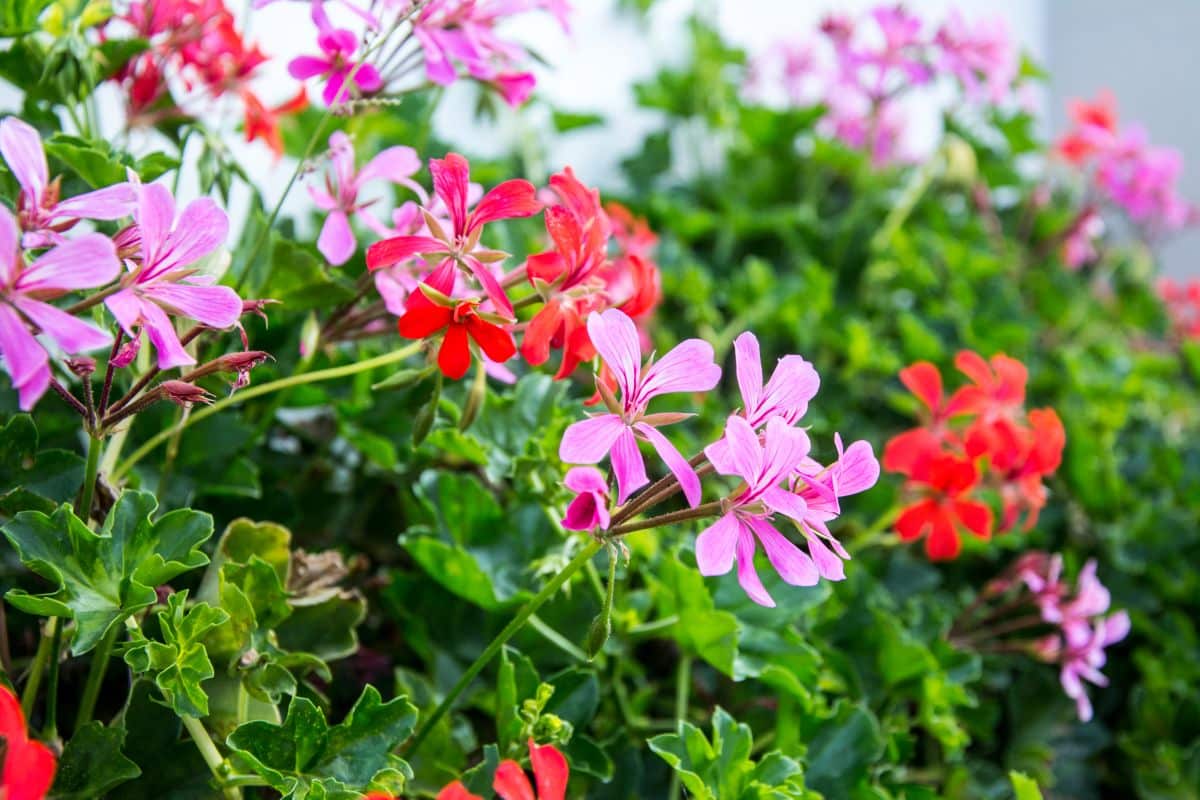
| Plant name: | Ivy geranium |
| Light requirements: | Bright light to part shade |
| Water requirements: | Moderate |
| Ornamental appeal: | Flowers |
Many different types of geraniums are suitable for container growing, but if you’re looking for a spiller plant, ivy geranium is the variety you need to find. These trailing plants grow between 1 and 3’ long, and they will dazzle you with their textured leaves and airy flowers in shades of pink, red, purple, and white. A solid choice for cottage garden designs, ivy geranium, looks particularly fetching when paired with other classics like dusty miller and sunflowers.
6. Nasturtium
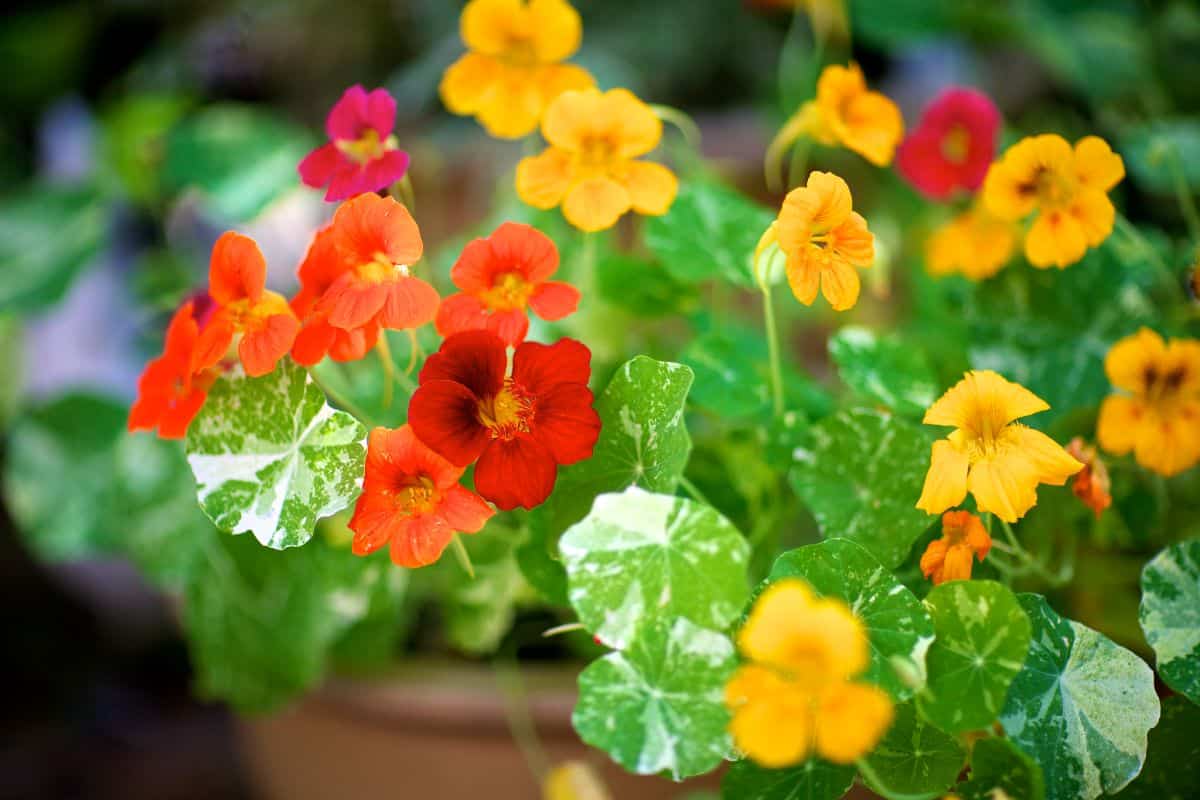
| Plant name: | Nasturtium |
| Light requirements: | Bright light to part shade |
| Water requirements: | Moderate |
| Ornamental appeal: | Flowers |
Nasturtiums are commonly grown in vegetable gardens and harvested for their edible leaves, flowers, and seeds, but nasturtiums can hold their own in any container arrangement too. These striking plants feature bright orange to yellow, trumpet-shaped flowers, which are always a hit with hummingbirds and bees. Plus, nasturtiums’ scent can repel pest insects from other plants in your container planter!
You can find both mounding and vining-type nasturtiums; however, vining nasturtiums are the type you’ll want to use as a spiller element.
7. Variegated ground ivy
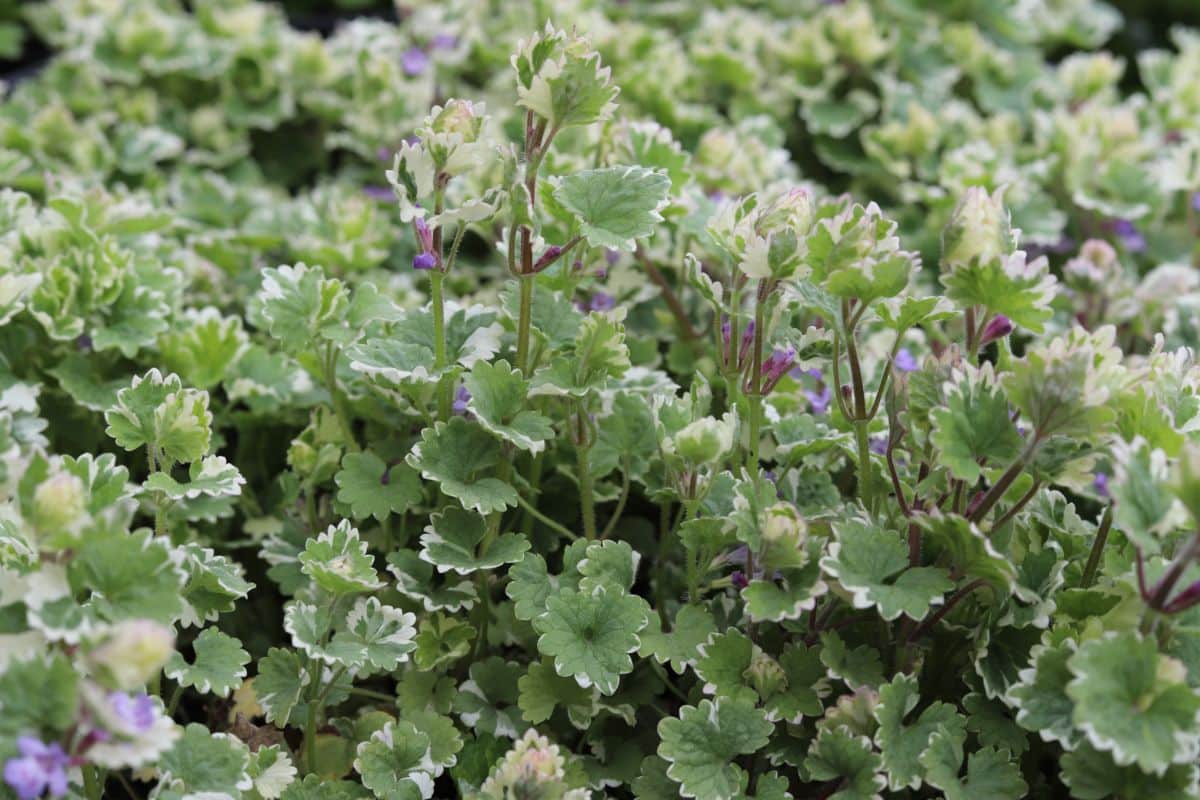
| Plant name: | Variegated ground ivy |
| Light requirements: | Bright light to part shade |
| Water requirements: | High to moderate |
| Ornamental appeal: | Foliage and flowers |
Ground ivy is often considered a weed, and it can grow invasively in some areas, so you may not want to grow it in a location where it can take over. That said, ground ivy is easier to manage in container gardens, and its hardy nature makes it nearly indestructible, even for “brown thumb” gardeners. While standard ground ivy has its charm (and tiny purple flowers!), variegated ground ivy has even more colorful leaves.
8. Fuchsia
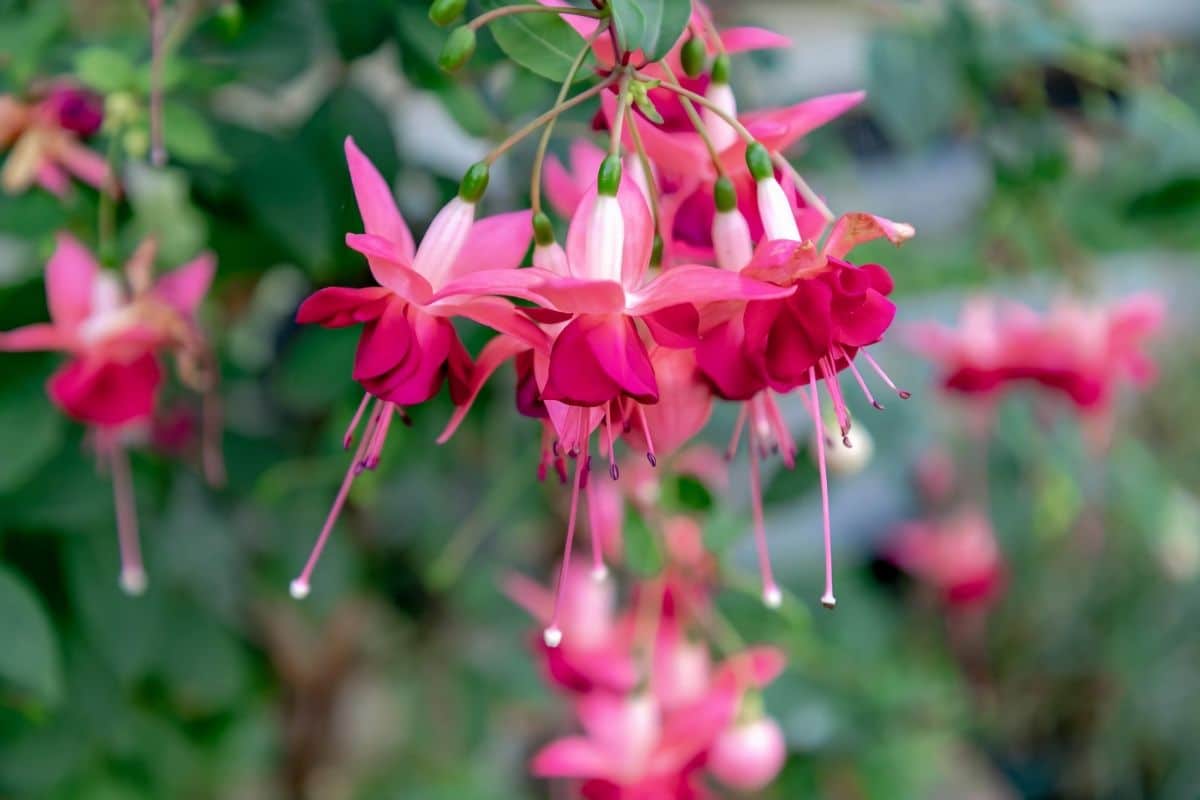
| Plant name: | Fuchsia |
| Light requirements: | Part shade |
| Water requirements: | High to moderate |
| Ornamental appeal: | Flowers |
Fuchsia plants are often grown in hanging baskets, but their trailing growth habit and dangling flowers also look just right in porch planters. Fuchsia flowers are magnificently colorful with a medley of magenta and purple hues, but you can also find fuchsia cultivars with variegated leaves if you want an even showier plant! Like many other brightly colored flowers, fuchsias are the top plants to grow if you want to draw hummingbirds to your landscape.
9. Asparagus fern
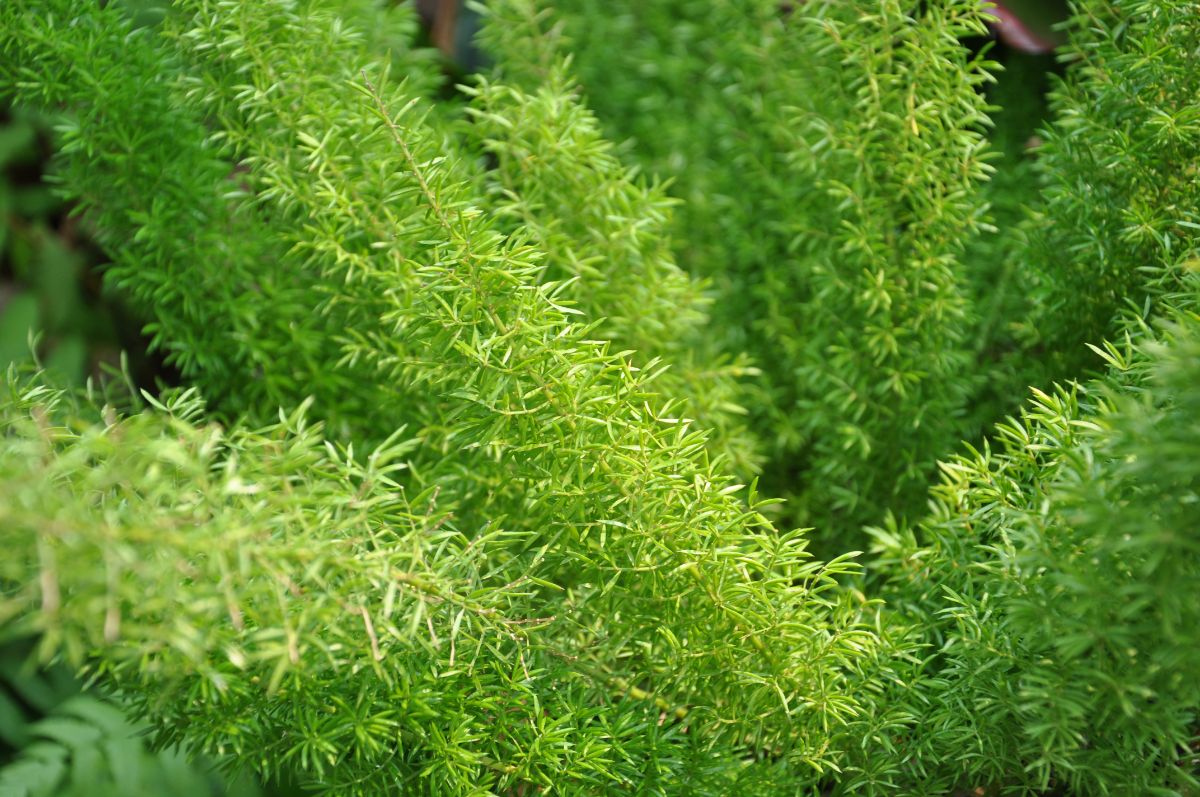
| Plant name: | Asparagus fern |
| Light requirements: | Bright light to part shade |
| Water requirements: | High |
| Ornamental appeal: | Foliage |
Asparagus fern is often grown indoors as a houseplant thanks to its airy leaves and trailing growth habit. In container gardens, these plants add structure and elegance and fit right in with plants like Swiss chard, heliotrope, and dracaena.
Despite their name, asparagus ferns aren’t true ferns, and they are actually more closely related to lilies. This perhaps explains why these plants have tiny thorns on their stems, which can prickle your fingers if you aren’t careful! Asparagus ferns are also toxic to pets, so be sure to keep them away from your furry friends.
10. English ivy

| Plant name: | English ivy |
| Light requirements: | Part shade |
| Water requirements: | Moderate to low |
| Ornamental appeal: | Foliage |
English ivy has a bit of a reputation in gardening circuits as being a difficult plant to keep under control. But if you grow English ivy in containers, these plants are much easier to manage.
English ivy has leathery, star-shaped leaves, which come in either solid green or variegated options. When allowed to trail over pot sides, English ivy adds a timeless touch, and it looks elegant with plants like dracaena and purple fountain grass.
Summary
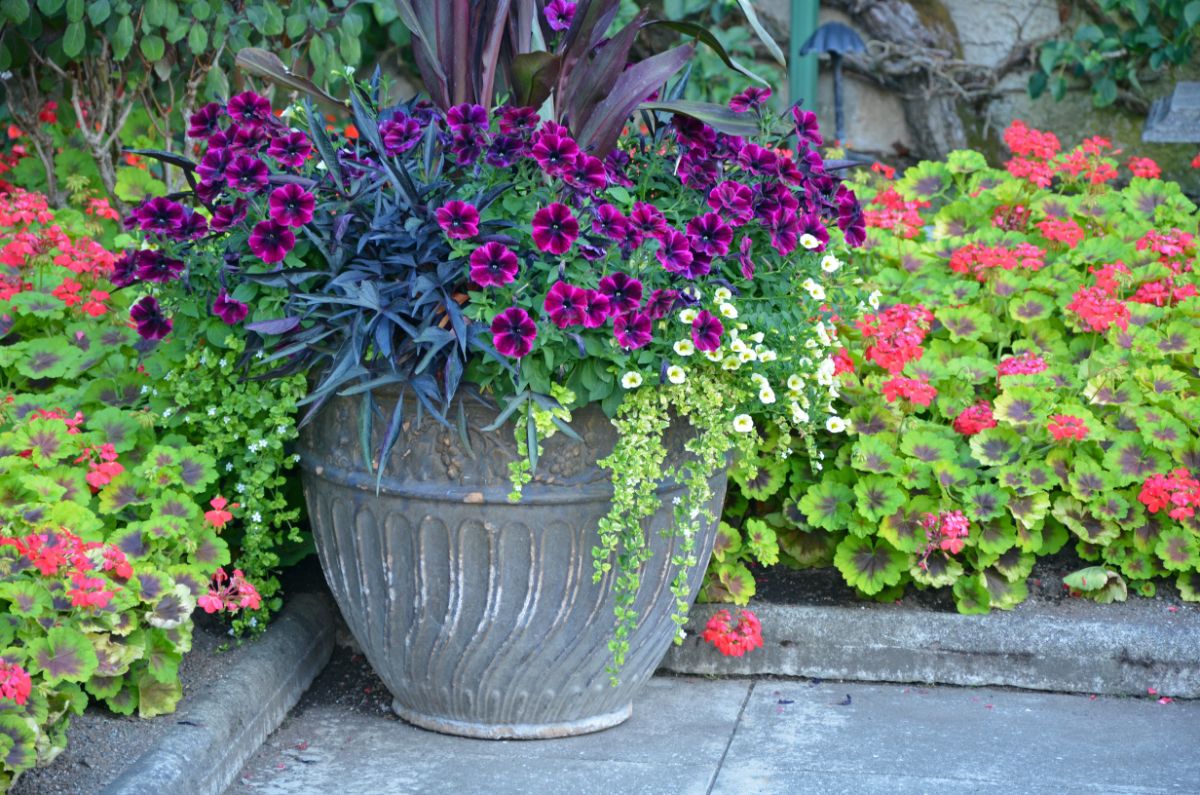
Keeping a container garden allows you to express your gardening creativity while giving you more places to grow plants! Even if you have a small backyard (or not a yard at all!), you can still keep a fabulous container garden and use the flowers you grow to accentuate your home’s curb appeal or draw the eye to walkways and patios. Choosing a combination of thriller, filler, and spiller plants will add complexity to your design, and it also gives you more choices on the variety and styles of plants you’d like to grow.
For more ideas on how to spruce up your curb appeal, see our guide on hellstrip gardening!

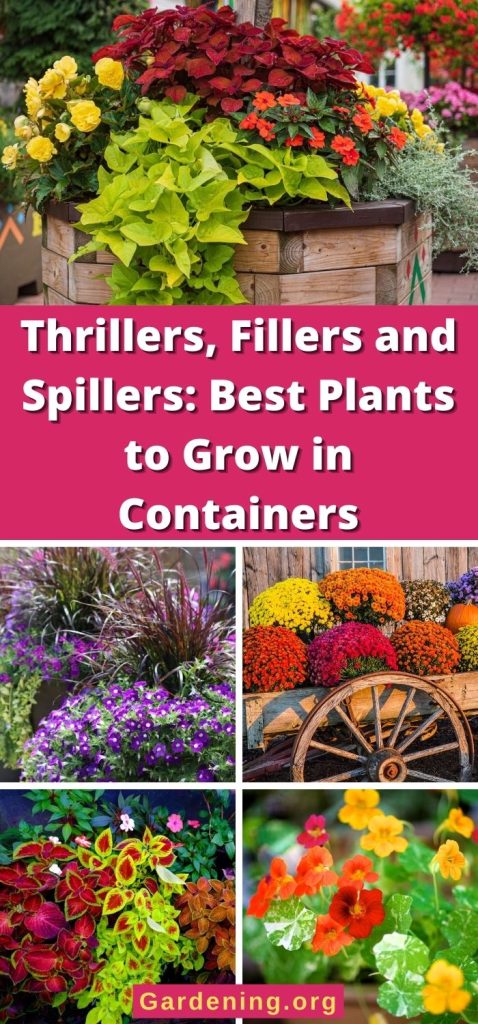
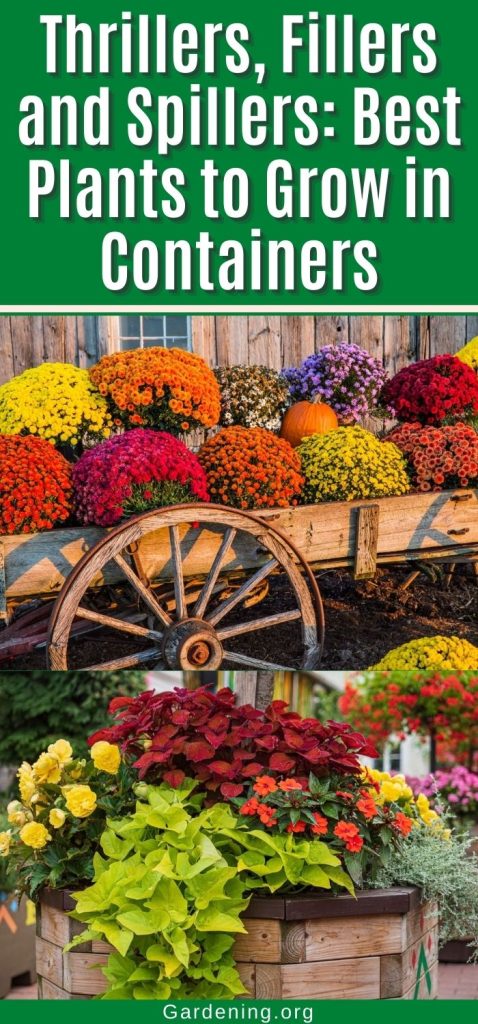
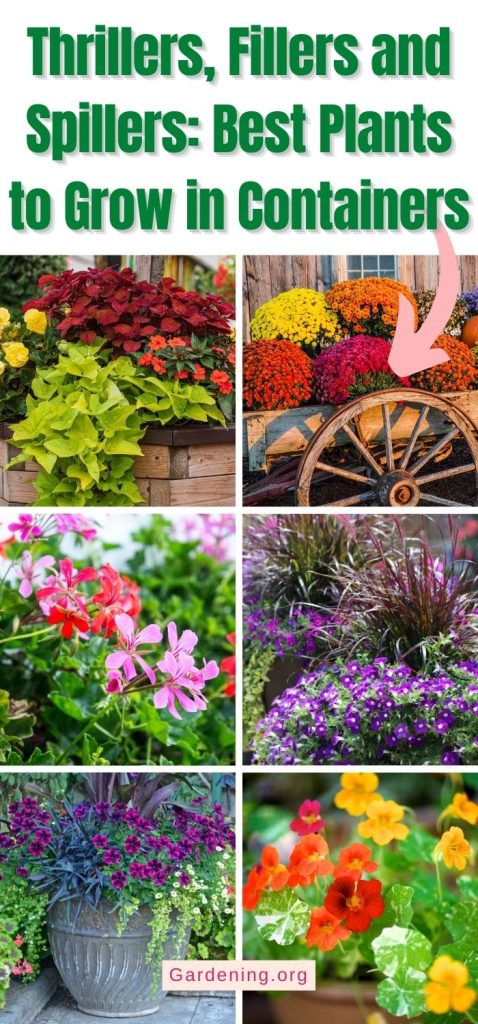
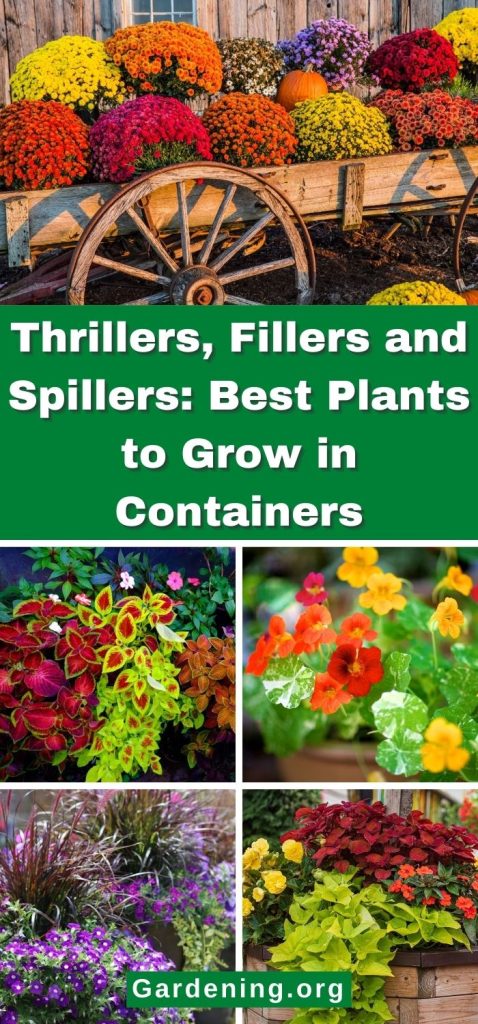
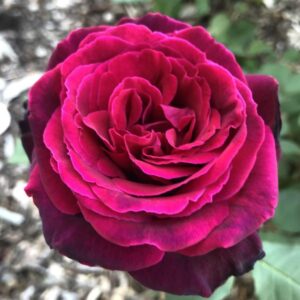
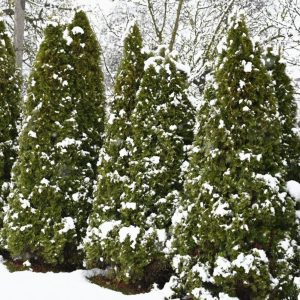


Leave a Reply